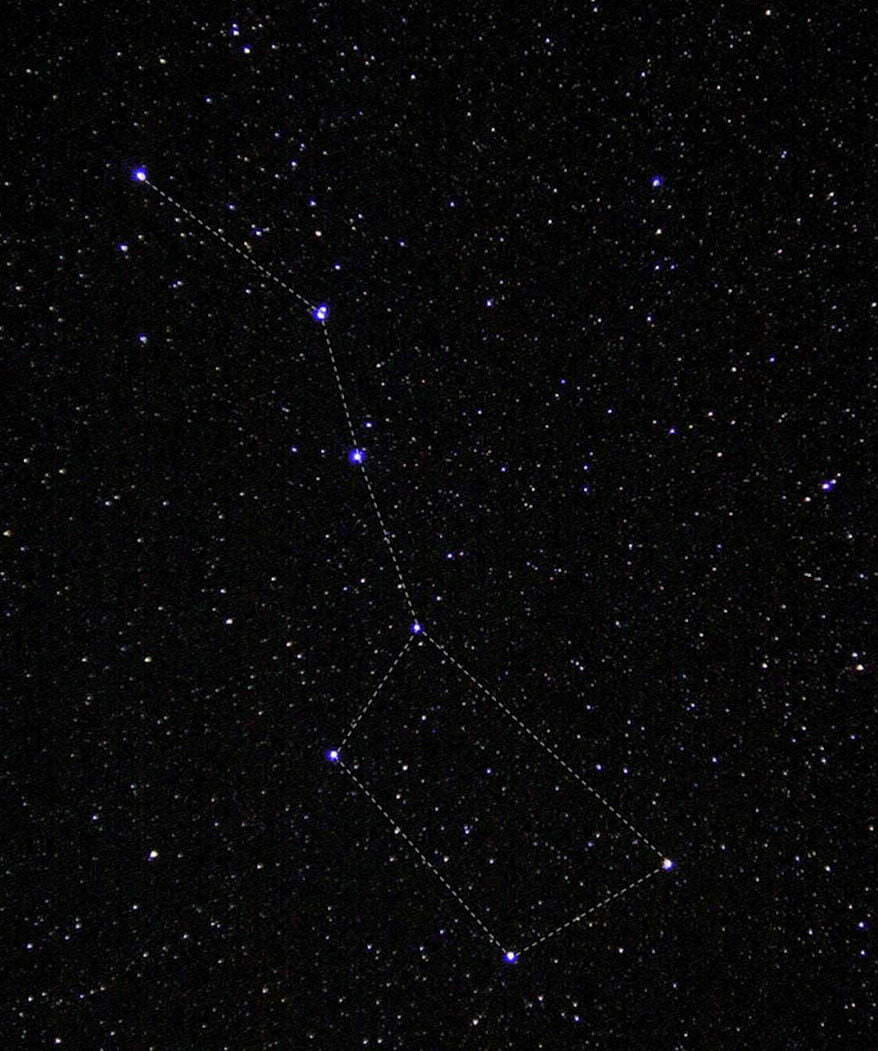Constellations are patterns of stars that form recognizable shapes or figures in the night sky. These patterns have been named and identified by various cultures throughout history. They are often used as a way to navigate and locate specific stars or celestial objects.
Constellations can be found in both the northern and southern hemispheres, although some constellations are only visible from certain latitudes. There are 88 recognized constellations in total, which encompass the entire celestial sphere.
Each constellation is made up of individual stars, but the patterns they form are not physically connected. The stars that make up a constellation can be located at vastly different distances from Earth and may not be related to each other in any way.
Some well-known constellations include Orion, Ursa Major (the Big Dipper), and the Southern Cross. These constellations have been named and recognized by many different cultures and have various mythological and cultural significance.
Overall, constellations are an important part of human history and culture. They have been used for navigation, storytelling, and as a way to connect with the stars and the universe.
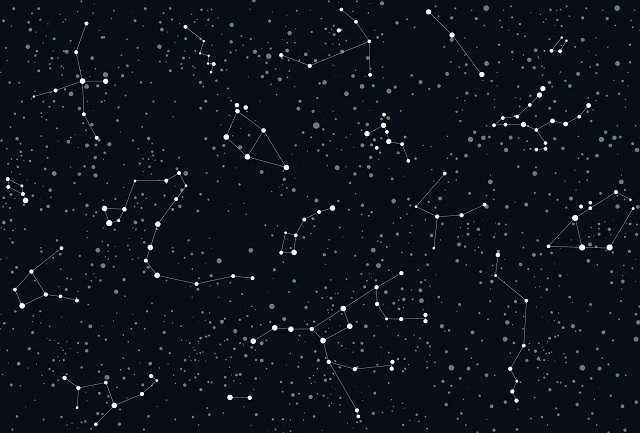
The stars and constellations serve as the enduring observers and protectors of civilizations long lost. Often, only myths and fables connected to enigmatic stars endure, preserving fragments of ancient knowledge.
What are constellations?
“What exactly is a constellation?” is a question that is both simple and complex. There are two versions of the answer:
The first version is purely scientific. According to this explanation, constellations are a collection of stars (celestial objects such as planets) that are located very far away from Earth and are arranged in a specific order. These groups of stars can resemble various objects, such as animals, humans, or birds.
The second version is more mystical and has its roots in ancient times. There are still believers in this version today. According to this interpretation, constellations are either the souls of deceased individuals or powerful artifacts that have been placed in the sky.

A comprehensive list of constellations
Currently, there are a total of 88 constellations that are known to modern civilization. The International Astronomical Union formally announced the numbers, names, and coordinates of each stellar group in Rome in 1922.
It is important to mention that there were numerous disputes regarding the “territorial boundaries” of each stellar group due to various inaccuracies. This led to extensive research and in 1935, a definitive decision on the boundaries was made. This decision is not subject to revision.
One fascinating and crucial aspect: out of the given quantity, over half (48 pieces) have been recognized and well-known to people since ancient times. They have been documented in numerous esoteric and astronomical texts (scrolls, clay tablets). It is worth highlighting – their boundaries were meticulously established by ancient scholars. As a result, only 40 constellations are officially acknowledged according to the document.
| № | Russian name (common terminology) | Latin name (scientific terminology) |
| 1 | Veronica’s hair | Coma Berenices |
| 2 | Lynx | Lynx |
| 3 | Telescope | Telescopium |
| 4 | Flying Fish | Volans |
| 5 | Southern Corona | Corona Australis |
| 6 | Pisces | Pisces |
| 7 | Andromeda | Andromeda |
| 8 | Scorpion | Scorpius |
| 9 | Bowl | Crater |
| 10 | Sagittarius | Sagittarius |
| 11 | Southern Hydra | Hydrus |
| 12 | Sextant | Sextans |
| 13 | Swan | Cygnus |
| 14 | Great Dog | Canis Major |
| 15 | Sacrificer | Ara |
| 16 | Hydra | Hydra |
| 17 | Painter | Pictor |
| 18 | Fox | Vulpecula |
| 19 | Capricorn | Capricornus |
| 20 | Circlet | Circinus |
| 21 | Sculptor | Sculptor |
| 22 | Southern Cross | Crux |
| 23 | Chamaeleon | Chamaeleon |
| 24 | Arrow | Sagitta |
| 25 | Virgo | Virgo |
| 26 | Chisel | Caelum |
| 27 | Whale | Cetus |
| 28 | Southern Triangle | Nriangulum Australe |
| 29 | Little Bear | Ursa Minor |
| 30 | Orion | Orion |
| 31 | Lyra | Lyra |
| 32 | Taurus | Taurus |
| 33 | Lesser Horse | Equuleus |
| 34 | Fodder | Puppis |
| 35 | Wolf | Bootes |
| 36 | Lion | Leo |
| 37 | Dove | Columba |
| 38 | Peacock | Pavo |
| 39 | Southern Fish | Piscis Austrinus |
| 40 | Giraffe | Camelopardalis |
| 41 | Centaurus (Centaurus) | Centaurus |
| 42 | Pegasus | Pegasus |
| 43 | Small Dog | Canis Minor |
| 44 | Triangle | Triangulum |
| 45 | Fly | Musca |
| 46 | Pump | Antlia |
| 47 | Perseus | Perseus |
| 48 | Aries | Aries |
| 49 | Big Dipper | Ursa Major |
| 50 | Eagle | Aquila |
| 51 | Keel | Carina |
| 52 | Northern Crown | Corona Borealis |
| 53 | Lizard | Lacerta |
| 54 | Shield | Scutum |
| 55 | Toucan | Tucana |
| 56 | Lesser Lion | Leo Minor |
| 57 | Naugolnik | Norma |
| 58 | Snake | Serpens |
| 59 | Compass | Pyxis |
| 60 | Aquarius | Aquarius |
| 61 | Gemini | Gemini |
| 62 | Crane | Grus |
| 63 | Cepheus | Cepheus |
| 64 | Reticulum | Reticulum |
| 65 | Scales | Libra |
| 66 | Goldfish | Dorado |
| 67 | Eridanus | Eridanus |
| 68 | Serpentine | Ophiuchus |
| 69 | Hercules | Hercules |
| 70 | Octanthus | Octans |
| 71 | Cancer | Cancer |
| 72 | Microscope | Microscopium |
| 73 | Sails | Vela |
| 74 | Phoenix | Phoenix |
| 75 | Unicorn | Monoceros |
| 76 | Hare | Lepus |
| 77 | Wolf | Lupus |
| 78 | Hound Dogs | Canes Venatici |
| 79 | Clock | Horologium |
| 80 | Bird of Paradise | Apus |
| 81 | Furnace | Fornax |
| 82 | Charioteer | Auriga |
| 83 | Table Mountain | Mensa |
| 84 | Dolphin | Delphinus |
| 85 | Indian | Indus |
| 86 | Dragon | Draco |
| 87 | Cassiopeia | Cassiopeia |
| 88 | Raven | Corvus |
Maps depicting the celestial sky and constellations
These visual representations of the nocturnal sky have long been recognized as a valuable and ancient tool for navigating and studying astronomy. They have been created since ancient times, appearing on the walls of stone structures such as tombs, temples, observatories, and other religious buildings, as well as on silk and paper scrolls and in books. Travelers often studied these maps to aid in finding their way in unfamiliar territories.
However, it is important to note that not all ancient maps were equally accurate. The maps from the Middle Ages, in particular, were often less precise. On the other hand, the maps created in ancient times and earlier continue to astonish scientists with their remarkable accuracy or minimal margin of error.
Currently, astronomers possess a wide range of cutting-edge technology with exceptional resolution. This enables them to create highly precise maps that can be utilized in computer systems or mobile apps.
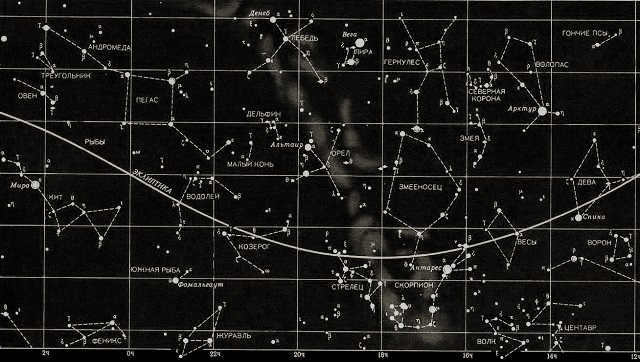
Celestial Objects’ Motion within Constellations
It might appear that the stars are motionless when observed from Earth, even to those who aren’t particularly interested in astronomy. However, these celestial bodies are actually located at such great distances from our planet that their movement is imperceptible. Even astronomers equipped with special instruments sometimes struggle to track their motion.
To address this issue, constellations are utilized: scientists determine the position of the object of interest within the star groups based on its movement and speed. Thanks to constellations, it has been discovered that the Moon is gradually shifting from west to east.
What do asterisms mean?
Asterisms, according to the general definition, are visible groups of stars that have their own names. They are considered remnants of the past and are often overlooked in literature and conversation.
Typically, these groups were named long before the field of astronomy became official. They have simple and straightforward names such as Belt, Cross, Butterfly, Sickle, Kettle or Jug, Circle (with different variations depending on the season), and more.
In the past, these asterisms were relied upon by sailors, travelers, and traders as reliable guides in unfamiliar territories. This was because the stars and constellations within these clusters were very bright, making it easy to visually construct various geometric shapes.
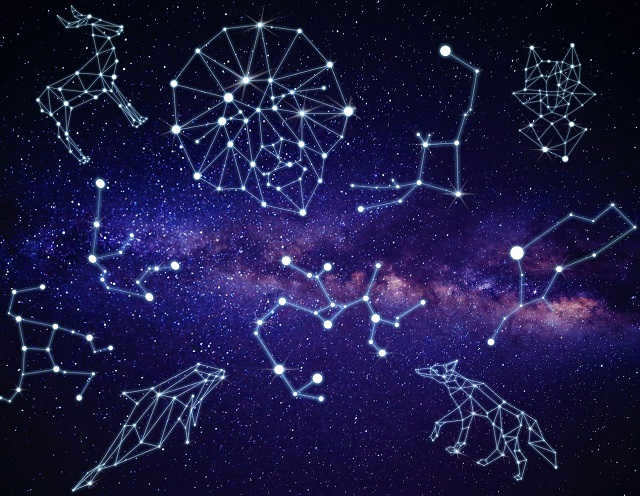
Distinguishing Between Asterisms and Constellations
It’s a reasonable question to ask, as both groups of stars contain bright stars and exhibit simple geometric shapes and lines.
So, let’s examine the distinction between them:
| Asterism | Constellation |
| Are named after everyday objects that were familiar to humans throughout history |
How the origins of constellation names came to be
The names of all known constellations are officially documented by the international society of astronomers. They can be divided into two groups: ancient names (48 constellations known to ancient scholars) and modern names (40 constellations).
The first group consists of names that are linked to ancient mythology and beliefs of Greece, China, and Rome. This is because the sky was considered the realm of the gods. Only those who received divine favor for bravery and valor in battle (or possessed scholarly minds and creative abilities) or had divine protection against enemies were able to ascend to the heavens.
Famous examples from mythology include Hydra, Hercules, Orion, Cassiopeia, the Big and Little Dipper, Gemini, Aries, Taurus, Snake, Taurus, Dragon, and Dolphin.
The modern names are also split into two categories:
All constellations in the first category contain the names of well-known animals, birds, and fish. This category was established in the 16th century by two astronomers: P. Dirkszoon and F. de Hautman. Examples include: Goldfish, Chameleon, Toucan, Flying Fish.
The second category is comprised of constellations named after scientific and household objects. These unique names were given to several constellations in the 18th century by N.L. de Lacaillem. Examples include: Compass, Furnace, Microscope, Keel, Sails.
Zodiac Constellations
Most individuals are familiar with a collection of 12 zodiac signs, which include Sagittarius, Pisces, Libra, Leo, Aries, Taurus, Capricorn, Aquarius, Gemini, Scorpio, and Cancer. This collection is known as the zodiac constellations, or as it is also poetically referred to as the “Belt of Heaven”.
If we solely consider the astronomical characteristics, the name of these groups of star clusters is derived from myths and legends from various countries and cultures. However, the majority of them originated from the literary heritage of ancient Greece and Rome.
Scientists rely on these 12 signs of the zodiac to monitor the movements of the planets, the Moon, and the Sun. By dividing the starry sky into 12 equal parts, these signs make it easier to track all the celestial bodies. This system simplifies the process of observing and studying the planets, satellites, and other celestial objects.
It’s worth mentioning that some sources recognize 13 signs of the zodiac, including the constellation of the Signifier. However, it is not officially included in the traditional zodiac due to the Earth’s axis gradually shifting over time.
Enthusiasts of esoteric teachings utilize these zodiac signs as tools for creating horoscopes and birth charts.
What is the total number of constellations in the sky?
This is an old and sometimes provocative question. When it comes to simple, amateur stargazing without any special equipment, the answer would be 3000 stars.
However, with advanced equipment, the number of celestial bodies increases significantly. It is estimated to be around 100 billion stars.
Furthermore, it should be mentioned that in the classification of “constellations,” 12 lesser-known constellations have been excluded. These include the Cat, Star Oak or House of Faerie, Lightning, and several characters from biblical stories.
Northern and Southern Star Clusters
All constellations can be classified based on their “territoriality”, that is, their location in either the northern or southern hemisphere.
It is worth mentioning that some star clusters are not permanent and only appear in one hemisphere during certain seasons. However, there are also permanent clusters that can be seen throughout all four seasons.
Some of the well-known constellations in the Northern Hemisphere (rising constellations) include:
- Ursa Major and Ursa Minor (the Big and Little Dipper).
- Lynx
- Draco (the Dragon)
- Cassiopeia
- Giraffe (Camelopardalis)
- Andromeda
- Cepheus
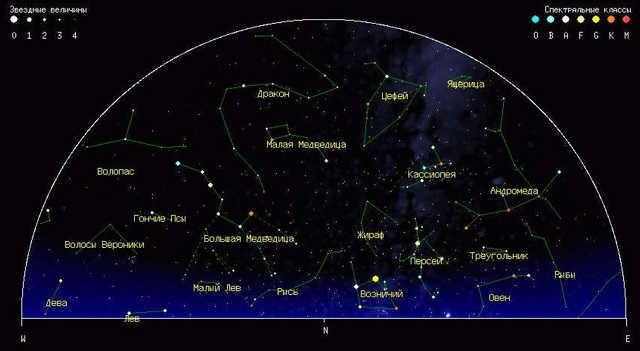
Renowned star formations visible in the celestial sphere of the Southern Hemisphere:
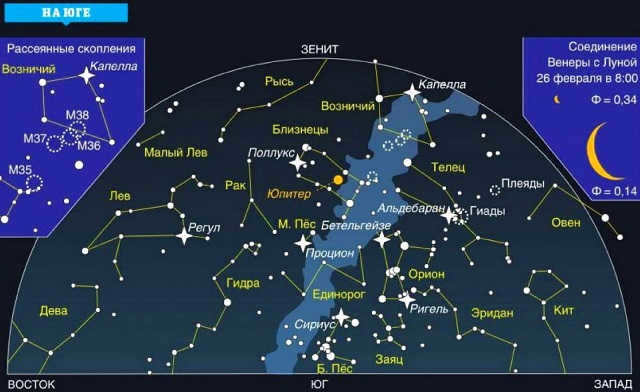
Constellations in the Spring Sky
As mentioned earlier, the positions of certain constellations in the sky change depending on the time of year.
It is worth noting that these changes occur in both the Northern and Southern Hemispheres. Therefore, it is crucial to know your location when observing the sky.
During the spring season, both the Northern and Southern Hemispheres have several constellations visible. In the Northern Hemisphere, you can see Ascendant, Cassiopeia, Andromeda, Perseus, Kiel, Corma, Sails, Bowl, Lynx, Hound Dogs, and both Hydras.
In the Southern Hemisphere, you can observe Gemini, Leo, Raven, Little Dog, Compass, Flying Fish, Wolopas, Centaurus, Fly, Southern Cross, and Pump.
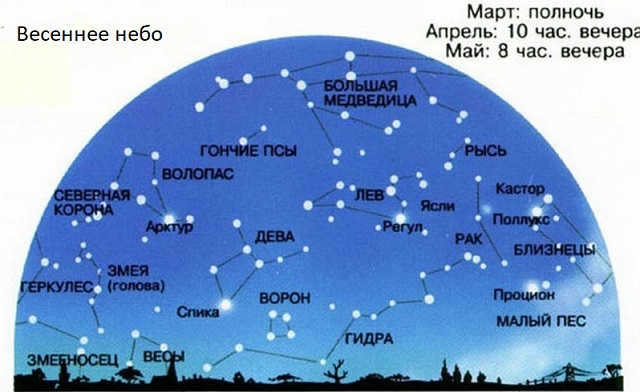
Constellations of the summer night sky
During the summer vacation period, many people enjoy going camping. It is the perfect time to observe the magnificent starry sky at night, far away from the hustle and bustle of the city.
In order to accurately identify the constellations, it is important to have a clear understanding of your location in the world.
In the Northern Hemisphere, you can find constellations such as the Northern Crown, Dragon, Volopas, Lyra, and Hercules during this time of year.
On the other hand, in the Southern Hemisphere, you will be able to spot constellations such as the Circlet, Southern Crown, Sagittarius, Scorpius, Sacristan, Serpent, Southern Triangle, Wolf, Naugol, Snake, Shield, and Telescope.
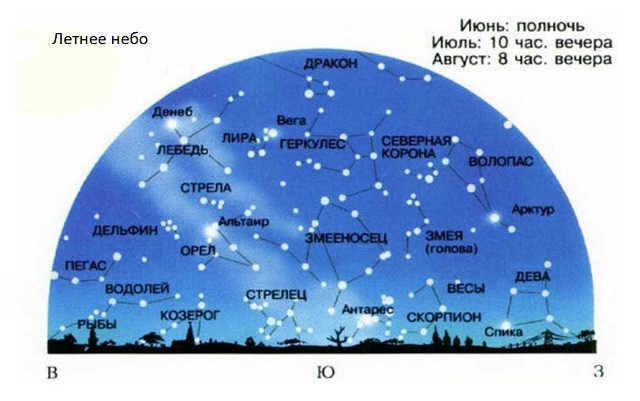
Constellations of the autumn sky
The fall season does not often provide us with a clear and cloudless sky. However, when such conditions arise, it is definitely worth exploring the constellations that dominate the night sky during this time of year.
In the Northern Hemisphere, stargazers can observe constellations such as the Dolphin, Eagle, Cepheus, Lizard, Little Horse, Pegasus, and Arrow.
In the Southern Hemisphere, individuals can observe constellations including the Crane, Capricorn, Peacock, Southern Fish, Phoenix, Swan, Indian, Aquarius, Microscope, and Ocanthus.
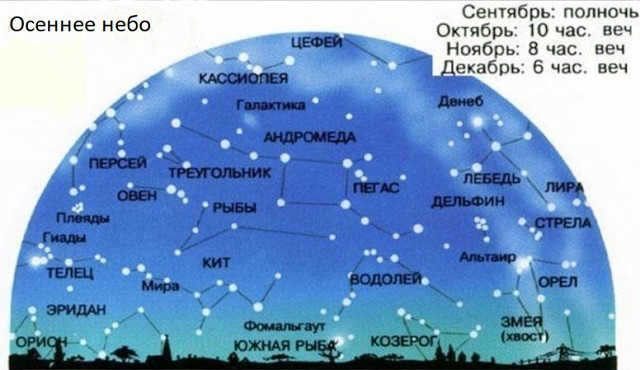
Winter Sky Constellations
During the winter season, when the weather is cold, there are not many individuals who are inclined to admire the stellar night sky in the great outdoors. Additionally, in a large urban area, it can be challenging to observe constellations due to the presence of smog and excessive artificial lighting.
Nevertheless, for those who maintain a desire to observe the celestial luminaries at night, it is still possible to identify several star clusters:
In the Northern Hemisphere, one can expect to see the constellations Perseus, Taurus, Aries, and Orion.
In the Southern Hemisphere, during this time of year, the constellations visible include Southern Hydra, Set, Whale, Eridanus, Pisces, Chisel, Table Mountain, Furnace, and Libra.
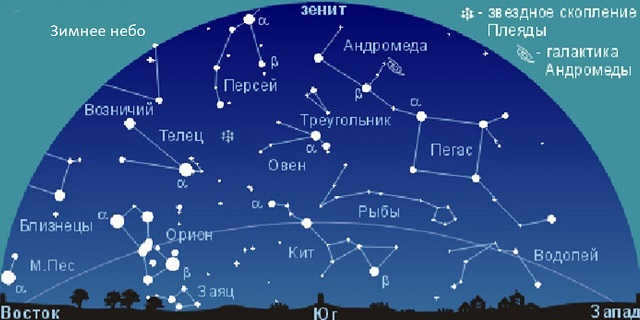
Boundaries of the Constellations
As mentioned earlier, there were no clear and officially established “boundaries” in the constellations before 1928. This led to occasional confusion, with one constellation being included in another or even forming a completely new and previously unknown one.
To determine the limits, researchers utilized ancient engravings and illustrations that depicted the constellations as objects bearing their names. Subsequently, specific mathematical equations were derived, enabling the determination of which constellation occupied a larger portion of the celestial sphere. Consequently, a corresponding inventory was compiled utilizing these calculations, displaying the name of the constellation alongside the respective extent of the sky it encompasses.
Origin and Evolution of Constellations
The origins and development of each constellation are captivating, diverse, and steeped in history. They trace back to ancient times, an era devoid of written records, leaving behind fragments of folklore and mythology that have endured to this day.
Among the most renowned sources of constellation history are the myths and legends of prominent civilizations such as Greece, Rome, China, the Sumerians, the Mayans, and Egypt. While the names and tales from Ancient Greece, China, and Rome have largely survived, others have been lost to time.
Across various cultures, it was believed that the stars and constellations represented the souls of guardians (ancestors, gods) who provided guidance and protection to the living.
It wasn’t until the 16th century that the systematic study and documentation of constellations began. Known constellations were officially recognized, while unfamiliar ones were gradually added to the celestial catalog.
And so it continued until 1922. In the annals of time, that year stands out as the momentous occasion when 88 constellations were officially recognized and established. The remaining 12 were deemed to be mere fabrications.
The renowned constellations
In the vast expanse of our world, it is an arduous task to encounter an individual (excluding astronomers!) who possesses an encyclopedic knowledge of all 88 constellations. Most individuals can only recall around 10 to 20 constellations from the extensive catalogue. These may include:
- The entire collection of 12 celestial formations known as the “Belt of the Sky”.
- The illustrious Big Dipper and its smaller counterpart, the Little Dipper.
- Both Hydras.
- The legendary Hercules.
- The captivating Cassiopeia.
- The enigmatic Dragon.
- The mesmerizing Andromeda.
- The renowned Orion, with a particular emphasis on the celestial arrangement known as Orion’s Belt.
- The distinctive Southern Cross.
- The majestic Northern Crown.
A captivating video about constellations
Discover in this article the most radiant constellations, their discovery history, and fascinating facts about them. Additionally, learn how to locate these star clusters in the night sky.
For centuries, people have observed the most brilliant constellations, composed of thousands of stars, in the nocturnal heavens. Over time, the concept emerged that these distant celestial bodies are interconnected in intricate formations, resembling mystical creatures or everyday objects. Through scientific advancements, astronomers have identified new star groups and divided the sky into 88 constellations.
What is the Definition of a Constellation?
A constellation, in the field of modern astronomy, refers to a specific grouping of stars. These groupings visually divide the celestial sphere into distinct regions and provide astronomers with a useful tool for navigating the starry sky. In ancient times, these patterns served as invaluable landmarks for sailors, aiding them in their navigation across vast bodies of water. For instance, the Big Dipper was a reliable guide for sailors in the Northern Hemisphere, while the Southern Cross provided direction in the Southern Hemisphere. The presence of the brightest constellation in the night sky was particularly helpful for ship captains, allowing them to steer their vessels accurately along their intended course.
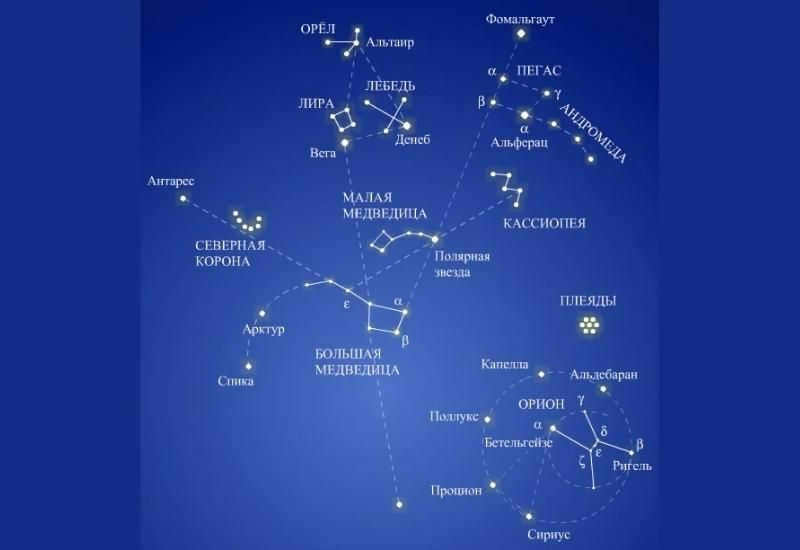
Ancient astronomers were intrigued by an interesting observation – within a single constellation, they could see both bright and dim stars. This phenomenon was later explained by the concept of small angular distances, where “neighboring” stars could actually be very far apart from each other.
As a result, each asterism contained a combination of stars that were both distant and close to the observer on Earth. Comparisons of which constellation had the brightest star helped astronomers remember the outlines of these star clusters.
The comparison of the brightest stars in different constellations
In ancient times, astronomers and astrologers were captivated by the brilliance of certain stars. It was believed that these luminous celestial bodies, situated within specific constellations, influenced the destiny of each individual. Consequently, wealthy and royal families often employed astrologers who possessed the ability to identify the names of the most radiant constellations. When a child was born, these astrologers would diligently observe the starry sky in order to predict the future path of the newborn.
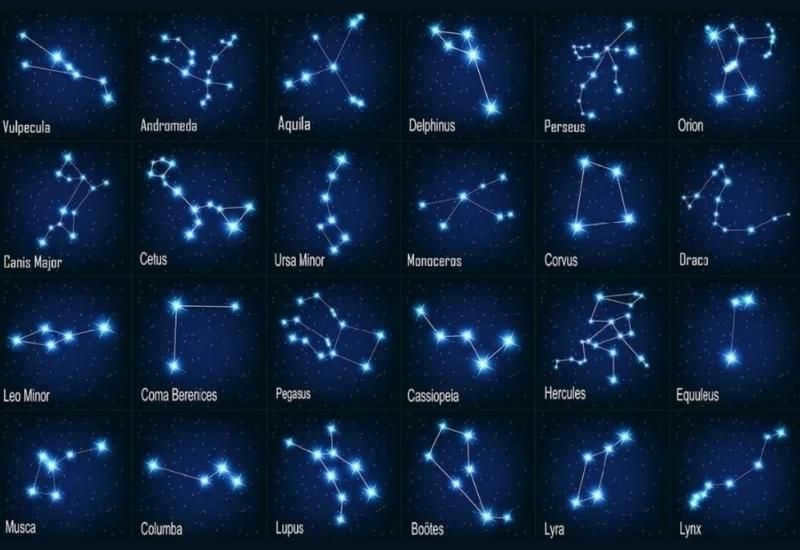
In today’s space enthusiasts’ world, astronomers also give significant consideration to the celestial bodies that illuminate the night sky. As part of their comparative study, they have compiled a table showcasing the most brilliant stars and constellations, complete with their names, designations, and visual stellar magnitude.
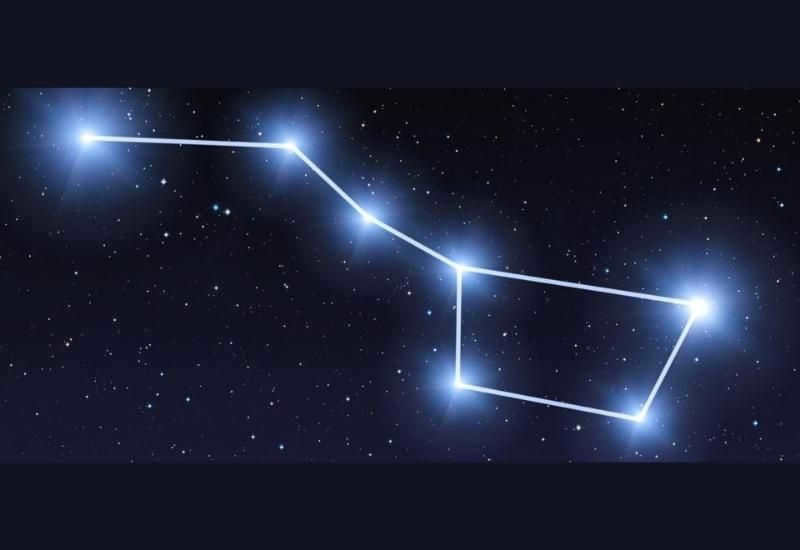
There are three stars “inside the handle” and the rest create a distinct bucket shape. If you draw an imaginary line through Dubhe and Merak, it is simple to locate Polaris.
The Small Dipper
This star cluster is part of the group of circumpolar constellations and can be seen with the naked eye in the Northern Hemisphere, particularly in Russia.
It is composed of 29 stars, with 7 being the brightest:
- Anwar Al Farkadin;
- Alif Al Farkadin;
- Urodelus;
- Yildun;
- Ferkad;
- Kohab;
- Polaris.
The Small Dipper is adjacent to other constellations: Cepheus; Giraffe; Dragon.
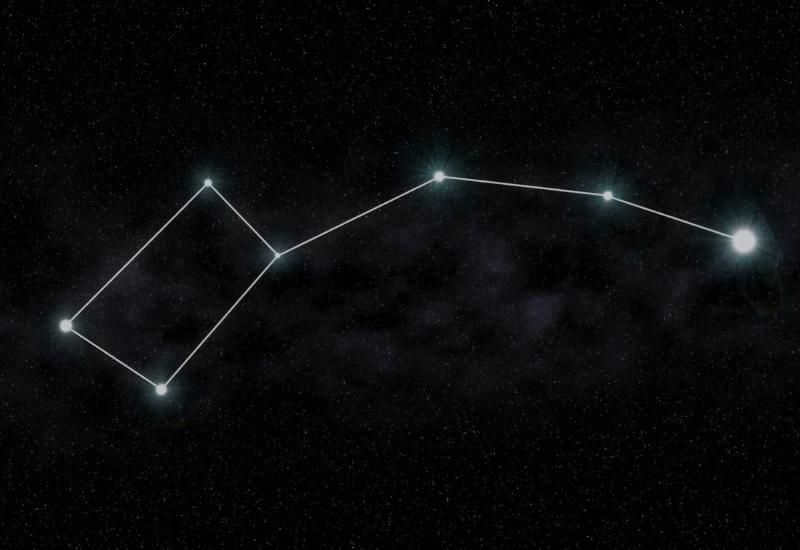
The Eagle Constellation
You can easily locate the Eagle constellation, which is situated southwest of the Swan constellation. Just look for the three bright stars that form the left shoulder, back, and neck of the majestic bird. On a clear night, it can be seen with the naked eye. If you have sharp eyesight, you may be able to spot up to seventy stars, but in general, only eight stars are brighter than the 4th magnitude.
The brightest stars in the Eagle constellation are:
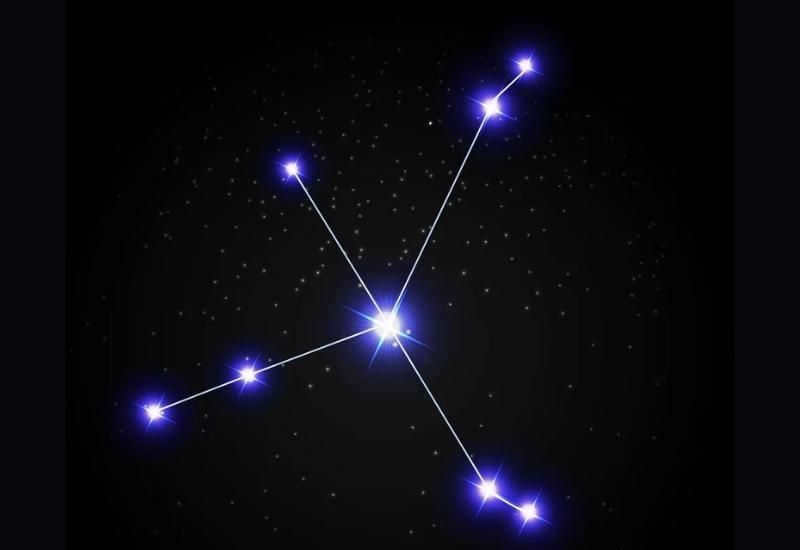
- The first star in the Eagle constellation is Altair;
- Another star in the Eagle constellation is η of Eagle;
- One more star in the Eagle constellation is FF;
- There is also a star in the Eagle constellation called TT;
- Finally, the last star in the Eagle constellation is U of Eagle.
The equatorial constellation is easily observable from Russia, particularly in its southern and central regions.
Volopassus
This constellation is one of the most stunning and largest celestial patterns, clearly visible in the northern part of the sky. It is characterized by a cluster of bright stars that visually form a fan-like figure. Within the “female accessory” handle, there is a red giant known as Arcturus. In terms of brightness, it is only surpassed by Canopus and Sirius.
The most luminous stars include:
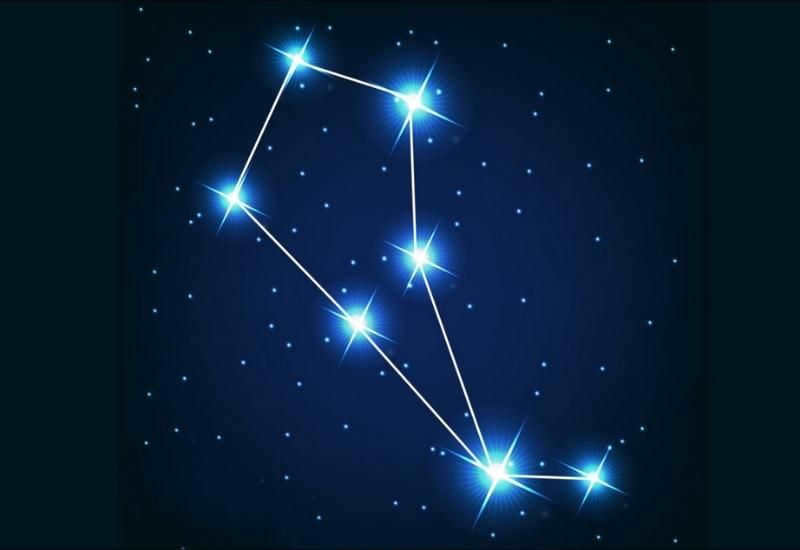
- Arcturus;
- Neckar;
- Seguin;
- Princesa;
- Pulcherrima;
- Mufrid;
- Asselus Tercius;
- Alcalurops;
- Merga.
The constellation Orion is surrounded by Hercules, Ursa Major, Serpens, Canes Venatici, Virgo, Corona Borealis, Coma Berenices, and Draco.
Orion
Astronomers admire the beauty of the constellation Orion, and with good reason. Its collection of bright stars is truly remarkable. By visually connecting these stars, one can see the figure of a hunter pointing towards Sirius from the southeast.
Most luminous stars:

- Alpha Orion (Betelgeuse);
- Beta Orion (Rigel);
- Bellatrix.
The constellation located at the celestial equator can be observed in its entirety during the winter season. It emerges above the horizon and becomes visible in the southeastern region of the sky. By February, it becomes observable in the southernmost point. The constellation consists of three blue-white stars, namely Mintak, Alnilam, and Alnitak, which form a straight line and are approximately equidistant from each other. These stars can serve as a guide to locating the constellation.
Lyra
A small constellation is one of the most stunning in the night sky. On a clear night, it is possible to see up to 75 stars without the use of a telescope. Among the brightest stars in Lyra is Vega. This beautiful constellation can be observed year-round, between the tropics of Cancer and Capricorn. It is also visible in northern latitudes. In Russia, astronomers have the best opportunity to admire this group of stars from May to October.
The most prominent stars in Lyra are:
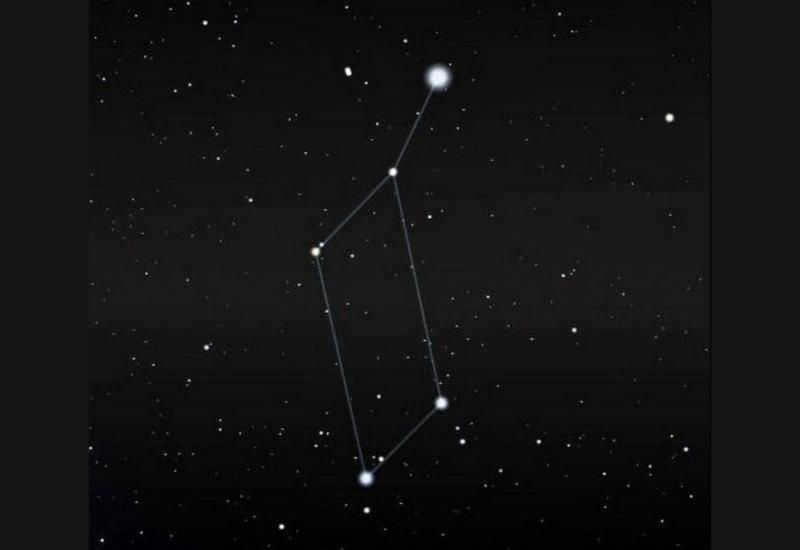
- The first star in the Lyra constellation is Vega.
- Another star in the Lyra constellation is Sheliak.
- RR Lyrae is also a star in the Lyra constellation.
- Lastly, there is Lyra Epsilon in the Lyra constellation.
Big Dog
The constellation of Big Dog contains a variety of celestial objects, including cepheids, double stars, and the Ring Nebula, which is believed to be the remnants of a small mass luminary.
Big Dog is a constellation that is partly located in the Milky Way and can be found southeast of Orion. It is particularly visible in the southern hemisphere during the months of December and January. The brightest star in Big Dog is Sirius, which is also known as the Dog Star.
One of the notable features of Big Dog is the presence of the red hypergiant VY Canis Majoris. This massive star is one of the largest known stars in the galaxy.
If you look 4 degrees away from Sirius, you will be able to spot two star clusters in Big Dog: M 41, also known as the Small Beehive, and NGC 2362.
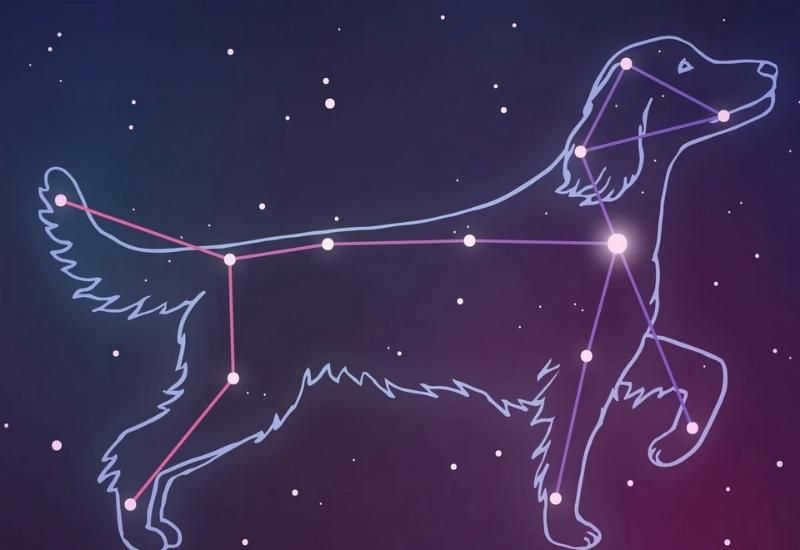
There are many myths and legends surrounding Sirius, the most brilliant star in the constellation. One such legend suggests that the priests of Ancient Egypt would forewarn their pharaohs, saying, “The great Sotis shines brightly in the night sky and the Nile will overflow its banks.” Observing this constellation from Russia is quite simple. “The Big Dog can be easily seen in the southern and central regions of the country. In the springtime, it is also visible in the southwest sky after sunset.”
Constellation Cygnus
Ancient stargazers named the cluster after the familiar shape it formed in the night sky. The arrangement of stars along the Milky Way resembled the graceful form of a swan. The Arabs referred to it as the “chicken” while the Babylonians called it the “bird of the forest”. In the Northern Hemisphere, the constellation can be seen from early summer to mid-autumn. In middle latitudes, it is visible throughout the year. In the vast territory of the former USSR, this group of stars can easily be observed directly above, especially towards the south.
The most prominent stars in the constellation are:
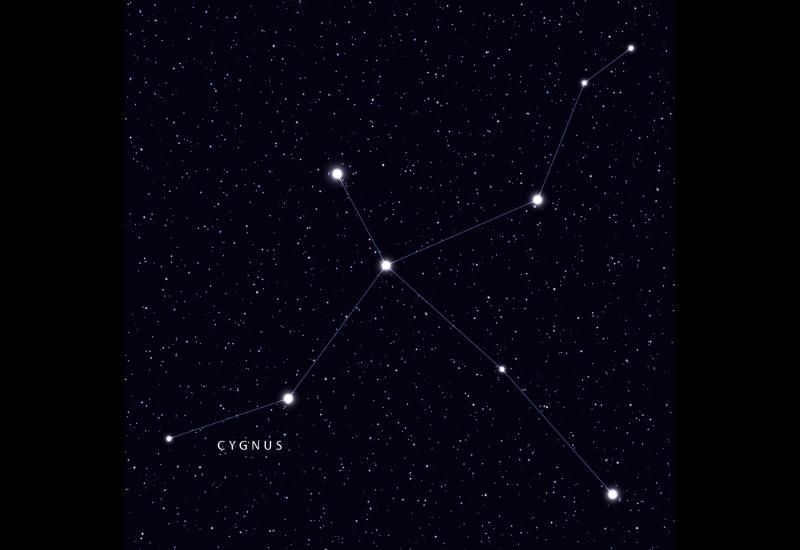
- The first star in the Swan constellation is Delta;
- The second star is Epsilon;
- The third star is Deneb;
- And finally, the fourth star is Albireo.
The constellation contains Swan X-1, an enigmatic object known for its strong X-ray emissions, which are likely caused by a Black Hole. It is classified as a binary system, consisting of the blue supergiant HDE 226868.
Cassiopeia
Cassiopeia, like the Ursa Major, can be easily seen with the naked eye throughout the year from rural areas. It consists of approximately 150 stars, and its prominent features serve as helpful navigational aids for sailors when their navigation equipment malfunctions. These features visually form the shape of the letter “W”.
The most notable stars include:
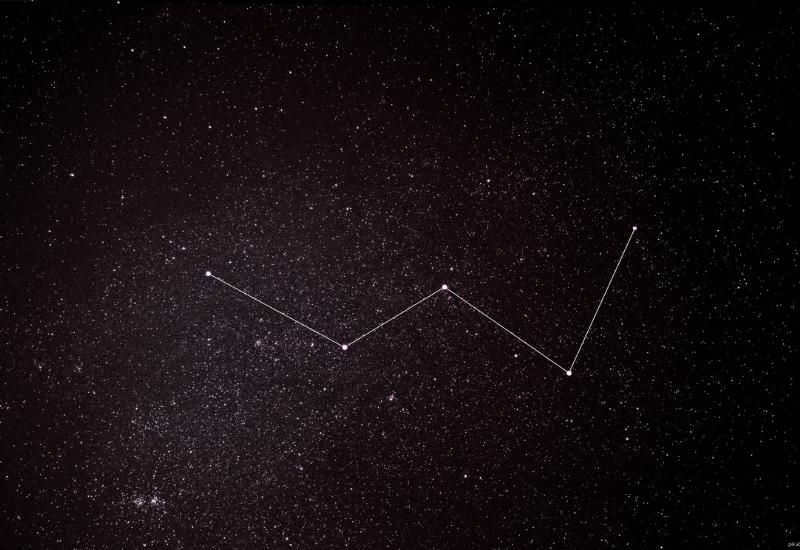
- Seguin;
- Rukbach;
- Navi;
- Shedar;
- Kaf.
Observing the celestial objects within the confines of the constellation has allowed astronomers to witness the beauty of nebulae, galaxies, and star clusters. One particular object of fascination is γ Cassiopeia due to its varying nature. Identifying the asterism is relatively easy, as one simply needs to mentally connect Polaris and ζ of the Big Dipper.
Andromeda
Observing three prominent stars in the Northern Hemisphere is an easy task – Alferanz, Mirach, and Alamac (which is a double star consisting of a yellow-orange object and a bluish companion). These stars form a distinct constellation. Andromeda is visible from any location in Russia, appearing in the southern part of the sky. To locate Andromeda, the observer should first identify the Grand Square of Pegasus and then locate Alferanz in the northeast corner. From there, three chains of stars extend towards Perseus.
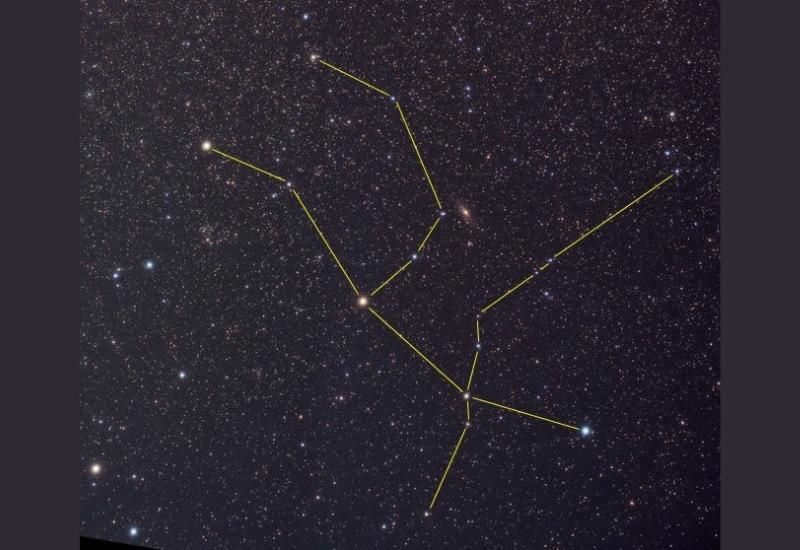
Within the Andromeda constellation lies the Andromeda Nebula, which is of great interest to modern astronomers. It is visible to the naked eye in the polar and temperate latitudes of the Northern Hemisphere.
According to a particular model of the universe’s development, the Andromeda Nebula is predicted to eventually “collide” with the Milky Way and merge with our galaxy in approximately 5 billion years.
Dragon
The Dragon constellation is part of the large constellations near the polar regions, and it is easily visible in the Northern hemisphere of the sky, including Russia. The best time for observing this constellation is from March to May. It is a constellation that contains numerous stars of different magnitudes, including variable stars, double stars, carbon stars, supernovae, stars with planetary systems, and other luminaries.
Some of the most fascinating stars in the Dragon constellation are:
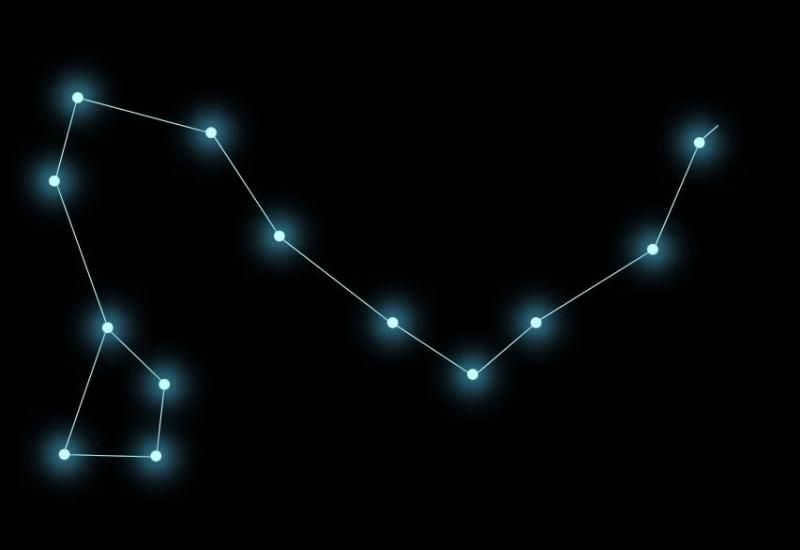
- Etamine is a giant star that shines in a bright orange color;
- Aldibayne, on the other hand, is a massive star that emits a warm, yellow glow;
- Rastaban, classified as a G2 star, is a prominent member of the Dragon constellation;
- Dragon Delta, a stunning yellow giant, catches the eye with its radiant presence;
- Dragon’s Zeta holds the distinction of being the fifth brightest star within the constellation;
- Dragon’s Iota, in contrast, is an orange giant that adds its own unique beauty to the constellation;
- Dragon’s Hee is a captivating star system comprised of two stars—a vibrant orange star and a dazzling white-yellow star.
The North Pole of the ecliptic can be found within the region of stars ζ, δ, χ, ξ. The pole of the Earth’s rotation undergoes a cycle every 25,7700 years. Currently, it is positioned close to Polaris.
Hercules
This particular constellation is the fifth largest and contains approximately 225 stars that are visible without the need for special optical aids.
Among the most prominent celestial bodies in this constellation are:
Within Hercules, there are a number of recognizable patterns, including the Cornerstone, the butterfly, and a double star (unnamed) consisting of a dwarf and a subgiant. Hercules can be observed in the Northern Hemisphere, including Russia.
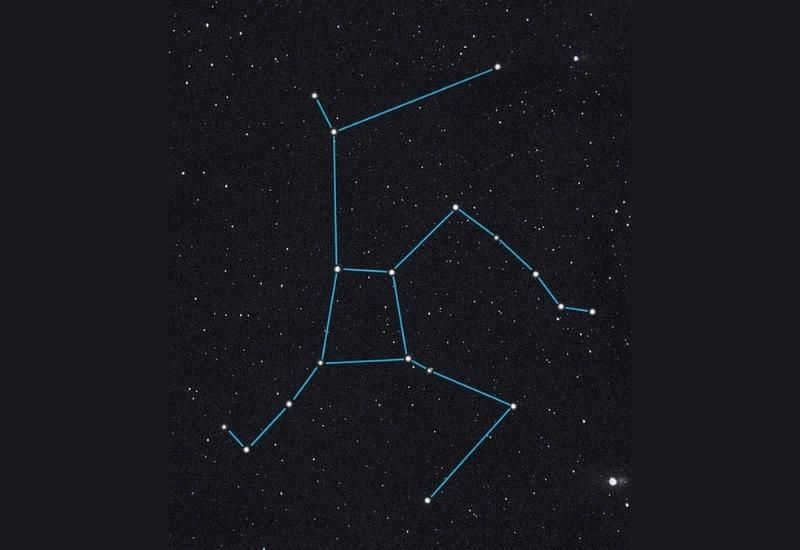
The optimal period for observation is June. The solar apex passes through this constellation, and it contains star clusters M13, M92, Nebula NGC 6210, and various other enigmatic celestial entities.
Ascendant
The constellation can be observed in the Northern Hemisphere, including all of Russia. The “Charioteer” is composed of numerous stars, with Capella being the brightest among them. It is also a source of X-ray radiation, which enables astronomers to develop intriguing hypotheses regarding the star’s future lifecycle.
Additional celestial objects:
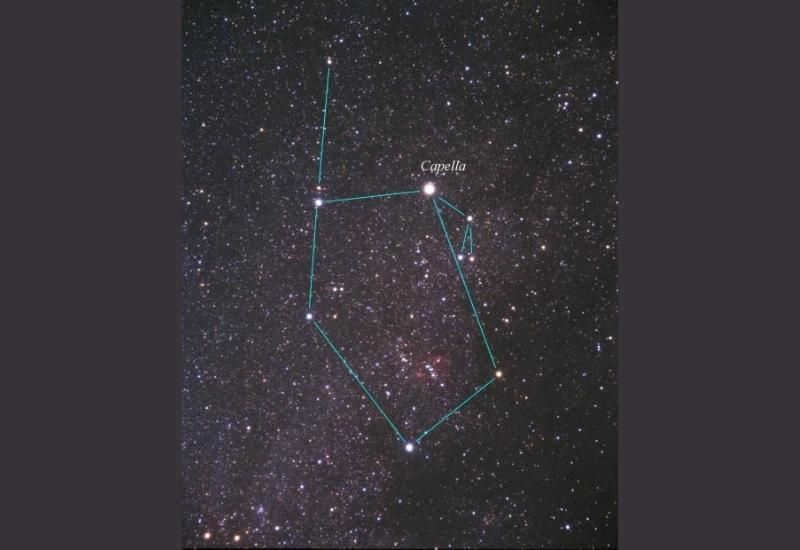
- Beta consists of three stars;
- Theta is a binary star;
- Iota is a giant star with an orange hue;
- Epsilon is a binary star that appears dim;
- Hedus II is a dwarf star with a white-blue color;
- Zeta is a red supergiant that appears like a “dwarf”;
- Delta is a double star;
- AE of Ascendant moves at a high speed;
- Lambda is a binary star.
Adjacent constellations to Pegasus include Lynx, Taurus, Gemini, Perseus, and Giraffe. The Flaming Star Nebula is situated in the Ascendant, along with clusters 36, 37, and 38 in the Messier catalog.
Pegasus
This constellation can be seen in the Northern Hemisphere without the need for a telescope and is located southwest of Andromeda. “Pegasus” is comprised of approximately 166 visible stars. The distinctive figure of the winged horse can be observed in Russia, with the best viewing time being from July to December.
The most brilliant stars:

- Sheat is a star that exhibits variability and has a gas envelope.
- Markab is one of the four asterisms that make up the Great Square.
- Enif is a supergiant star.
The Pegasus constellation contains a variety of enigmatic celestial bodies, such as the gravitationally-lensed quasar known as Einstein’s Cross, the globular cluster M 15, and the spectral galaxy NGC 7331. Astronomers are particularly intrigued by Pegasus because it is believed that this region could potentially harbor a Black Hole, an enigmatic entity whose rotational speed can reach up to 70% of the speed of light.
Perseus
The collection of stars known as Perseus is situated in the northern region of the sky and can be observed from the central and southern parts of Russia.
This cluster is comprised of numerous stars, with the most prominent ones being:
- Mithrak – an enormous supergiant;
- Algol – a member of the variable and eclipsing celestial bodies;
- BD+31° 640 – located at a distance of 753 light-years from our solar system.
This constellation is named after an ancient Greek hero who was able to successfully slay the Gorgon Medusa, as depicted in heroic legends.
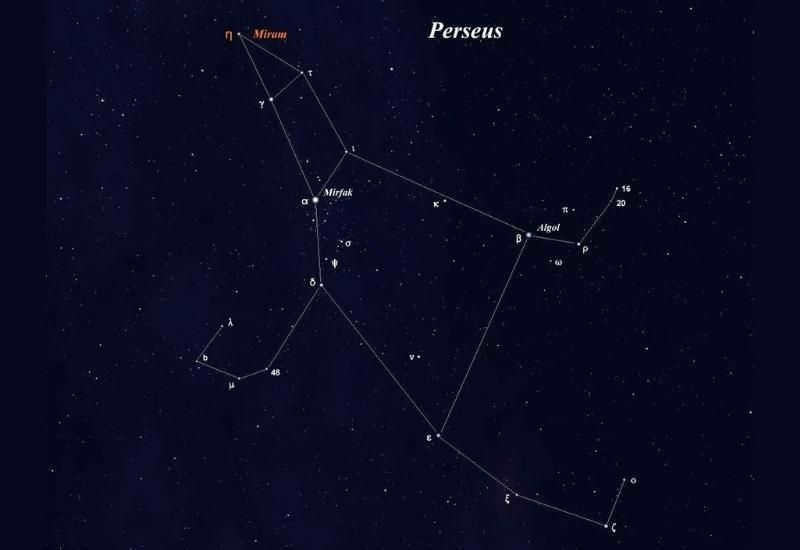
The Constellation of Cepheus
Cepheus is a constellation that has a shape resembling an irregular pentagon. It can be observed in the Northern Hemisphere, making it accessible to observers in Russia throughout the year. The southern part of Cepheus is located within the Milky Way. This constellation is home to 148 stars, which can be seen without the need for a telescope. However, it lacks bright luminaries.
There are several fascinating objects that have been discovered within Cepheus:

- Kruger 60. A binary star consisting of two dwarf stars;
- VV Cepheus. An eclipsing binary star system;
- Mu Cepheus. A red hypergiant known for its unusually large size.
The constellation contains various fascinating celestial objects such as the galaxy NGC 6951, the star clusters NGC 7226, 7160, 7142, 6939, 188, and more. One notable feature is the Nebula IC 1396, which is known for its active star formation. Additionally, the movement of the North Pole of the world is causing it to shift towards this constellation.
Compilation of the Most Brilliant Star Clusters Beyond a Single Constellation
Utilizing a telescope, astronomers have the remarkable ability to observe and study more than just one constellation, revealing a plethora of five exceptionally luminous stars. However, these celestial bodies are frequently situated outside the confines of the same cluster, exhibiting intriguing patterns that resemble scattered conglomerates or irregular geometric shapes. The meticulous examination of renowned asterisms serves to enhance the scientific community’s understanding of the vast expanse of the cosmos.
Experienced astronomers are not surprised to find that the brightest groups of stars are often found outside of a single constellation. For instance, the well-known constellation Orion is situated in the Northern Hemisphere and is surrounded by other equally bright stars. Similarly, the constellation Cepheus is next to the Little Bear, where one can observe other luminous stars with a high level of brilliance in the night sky.
The Pleiades
The Pleiades is a well-known cluster of stars that can be found in the Taurus constellation. It was named after the nymphs from ancient Greek mythology.
Even without using a telescope, it is possible to see the brightest stars in this cluster:
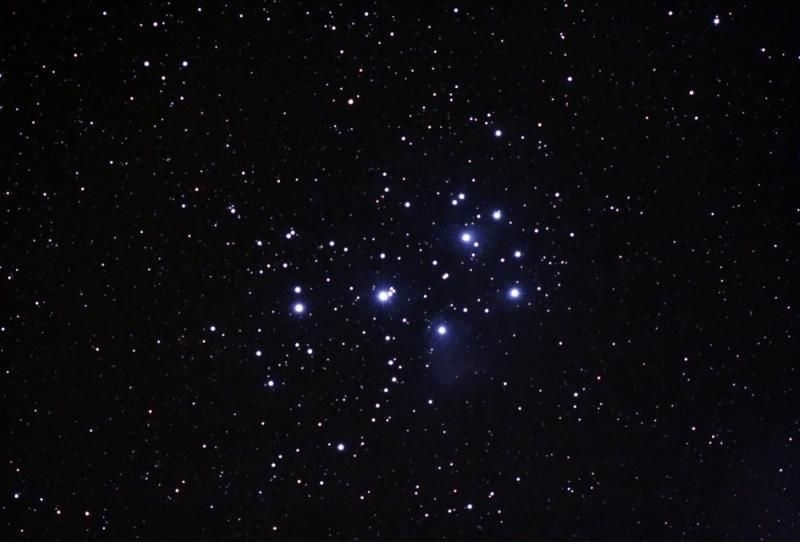
- Alcyone;
- Atlas;
- Electra;
- Maia;
- Merope;
- Taygeta;
- Pleione;
- Celeno;
- Asterope.
Meanwhile, there are numerous other celestial bodies in the universe. Rough calculations suggest that there are approximately 3000 entities with varying mass, luminosity, and density. It is widely accepted that the Pleiades cluster is one of the closest groups of stars to Earth, with a distance of no more than 135 parsecs from our solar system.
Hyades
The nearest dispersed constellation of stars to Earth. The Hyades is located 45 parsecs away, but many stars are far from the center by a significant distance. For instance, the tidal tails stretch out 800 pc. A portion of its origin is suggested by an age of approximately 650 billion years. This implies that the Hyades might have formed simultaneously with another cluster known as the Crèche.
There are over 700 entities that belong to this group of stars, and the most brilliant ones include:
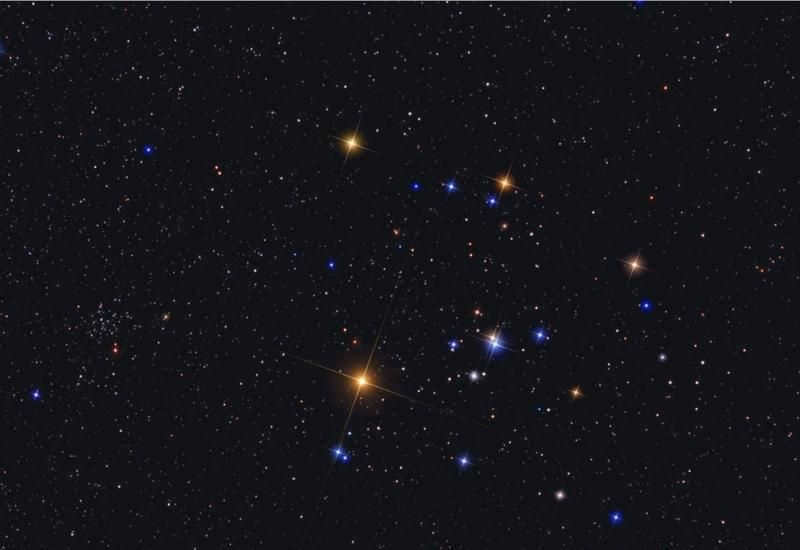
- The second star of Taurus;
- Epsilon of Taurus;
- Gamma of Taurus;
- Delta of Taurus;
- The first star of Taurus;
- Kappa one of Taurus;
- Epsilon of Taurus;
- Delta three of Taurus;
- 71 of Taurus.
The Hyades are positioned at the closest distance to the Sun, approximately 18.39608362839 parsecs, around 800,000 years ago.
Triangle of summer and autumn (Deneb, Altair, Vega)
In mid-latitudes of the Northern Hemisphere, the Summer-Autumn Triangle is readily visible. This well-known arrangement consists of three brilliant stars found in the constellations α Lyra, α Swan, and α Eagle. An identifiable formation in the nighttime sky can be observed during the winter and spring months from the Southern Hemisphere, specifically in lower latitudes. In this region, the triangle can be seen in the northern part of the sky, situated low above the horizon.
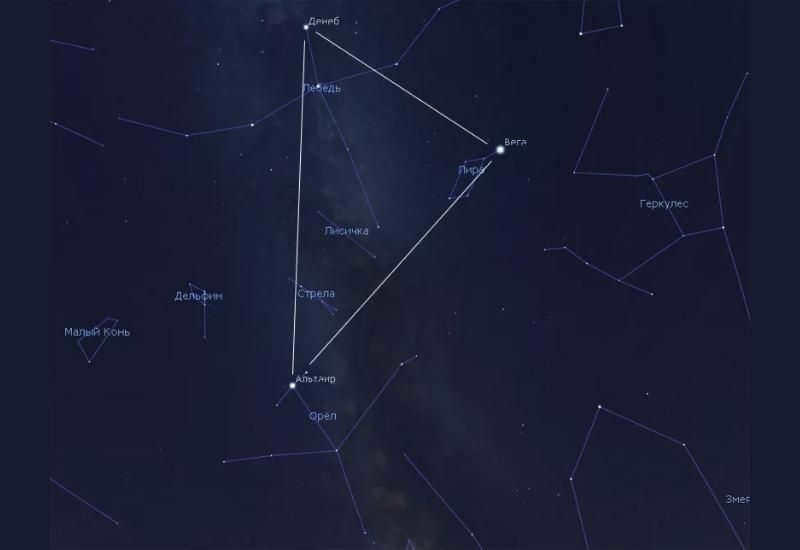
Spring Triangle (Arcturus, Denebola, Spica)
In Russia, the Spring Triangle is not easily visible during the arrival of the spring season, but it is most easily distinguished in the equatorial region of the sky. The constellations of Volopassus, Virgo, and Leo are home to the brightest stars of this asterism, including Arcturus, Spica, and Denebola. Some modern astronomers have “enhanced” the perception of the Summer Triangle by adding the “double Heart of Charles,” which is located in the constellation of Hound Dogs, to observe the characteristic rhombus known as the Necklace of Virgo. However, this asterism cannot be seen in the vicinity of the poles.
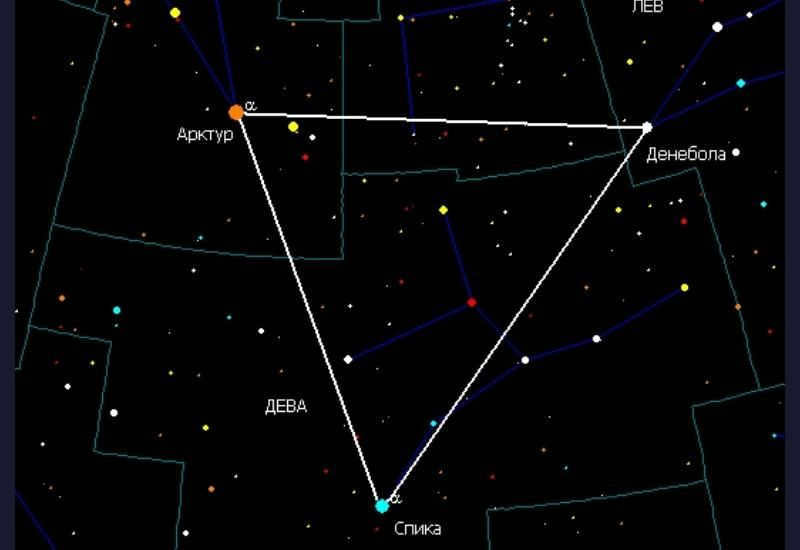
Winter Triangle (Sirius, Betelgeuse, Procyon)
An assemblage of stars situated in the equatorial region of the heavens and comprises of three prominent celestial bodies positioned within the constellations of Canis Major, Orion, Canis Minor. The Winter Triangle is comparably smaller in size when compared to the Vernal Triangle, it is overshadowed by the Winter Circle, and can be observed in the Northern Hemisphere (early spring, autumn mornings), all throughout the winter. It serves as a useful guide for locating the winter section of the Milky Way.
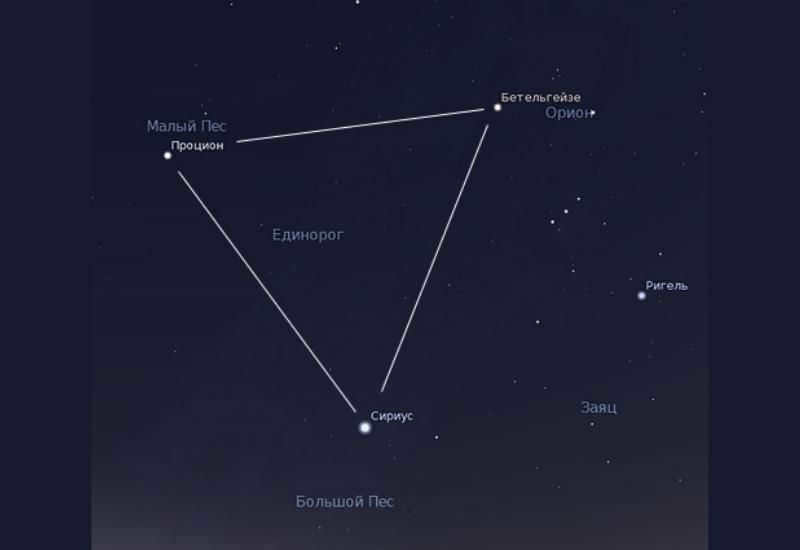
Summary
Galaxies consist not only of stars, but also of constellations and asterisms that help us navigate the night sky.
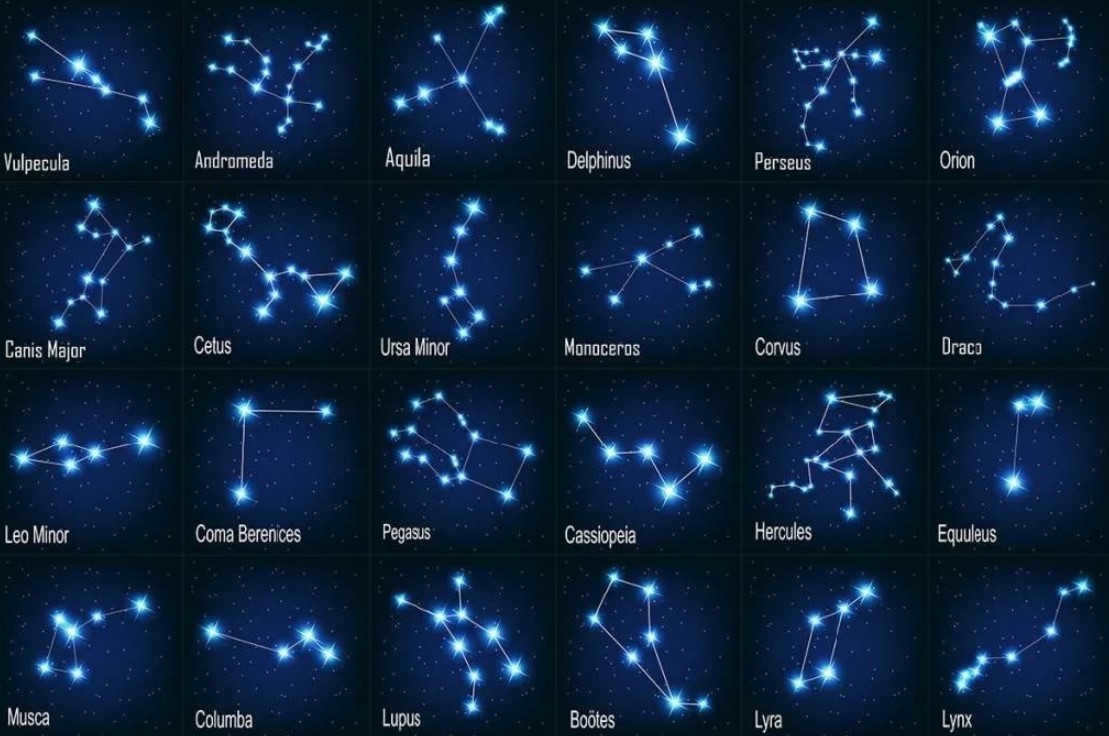
⭐ By disregarding all myths and folklore and focusing solely on scientific facts, constellations in the sky are distinct areas that divide the celestial sphere. This categorization of celestial bodies allows for easy navigation in space. Simply knowing what the starry sky should look like during specific times of the year is enough to navigate with ease. This pattern was observed by ancient civilizations, who laid the foundation for the field of astronomy.
The names and legends of the constellations in the night sky were swiftly acquired, with clusters of stars becoming linked to gods, mythical creatures, and various aspects of human existence. However, the system was flawed and imperfect, as certain stars were part of multiple constellations while others were deemed redundant in the celestial expanse.
10 well-known constellations in the sky and their names and diagrams
The division of the sky into regions was discussed at the 1922 meeting of the International Astronomical Union. The Commission officially recognized 88 constellations. However, only 54 of these constellations are visible in Russia due to the country’s geographic latitude. This article aims to provide information about the 10 most renowned and easily identifiable star clusters in the sky, accompanied by visual representations.
1. Dragon (Draco)
Dragon, also known as Draco, is a mythical creature that has been a part of folklore and mythology for centuries. It is often depicted as a large, reptilian creature with wings, scales, and the ability to breathe fire. In many cultures, dragons are seen as powerful and fearsome creatures, capable of bringing destruction and chaos. However, in some cultures, dragons are seen as wise and benevolent beings, bringing good fortune and protection.
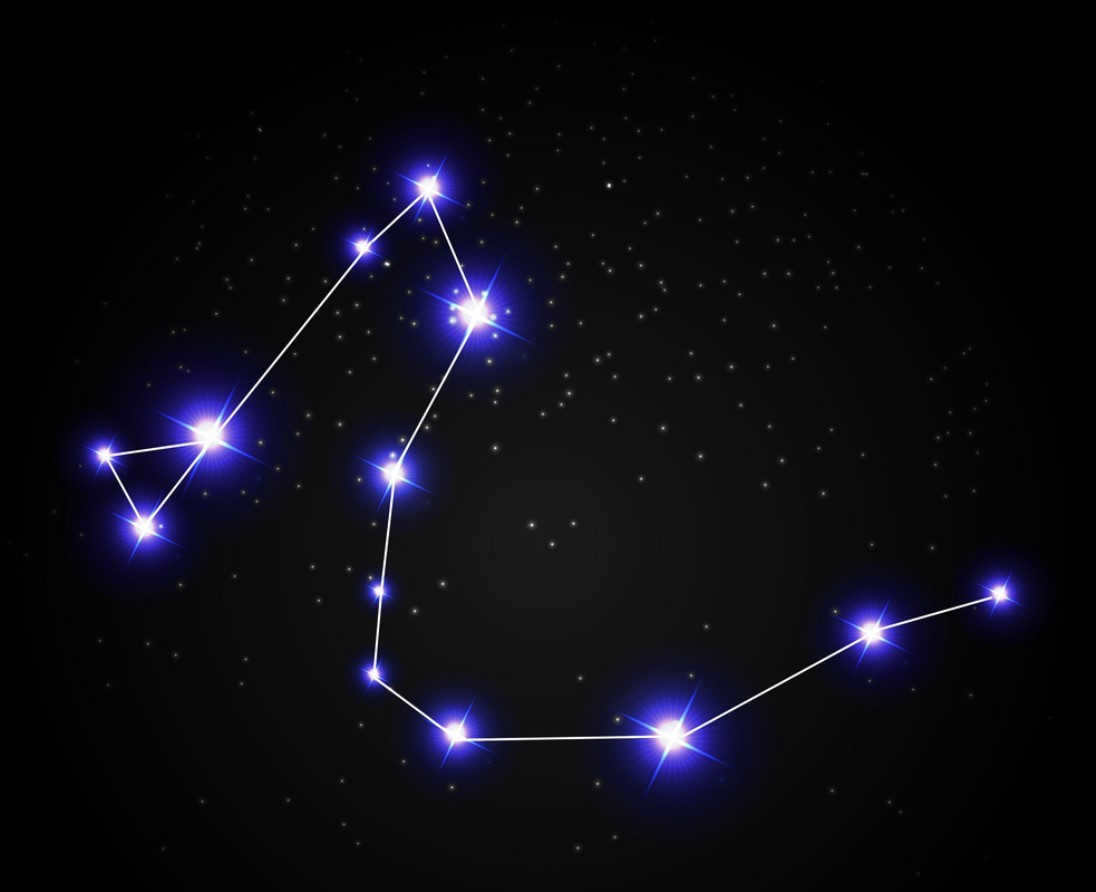
Constellation Size: Covers an area of 1083 square degrees.
Draco constellation is known to be one of the largest groupings of stars, with a solid expanse of 1083 square degrees by cosmic standards. It can be challenging to identify it accurately in the night sky as there are other more prominent constellations. In the Northern Hemisphere, Draco can be found in the region between the Little Dipper and the Big Dipper.
The stars that form Draco are not particularly bright, with their brightness not exceeding 6m (which is how astronomers measure brightness). In the vicinity of the Big Dipper, an elongated curve with a quadrangle at the end can be observed. This grouping of stars is considered to represent the head of the mythical dragon.
The constellation is visible from May to December, although the Dragon is most effectively observed during the summer and autumn seasons.
The legendary dragon is enveloped in myths and remarkable tales, much like the constellation bearing its name. As the myth goes, the colossal creature dared to challenge the deities residing atop Mount Olympus. Enraged Athena hurled the serpent directly into the heavens, where it has remained ever since.
2. Cepheus
Cepheus is the name of a constellation in the northern hemisphere. It is located near the Pole Star and is part of the ancient Greek constellation system. Cepheus is depicted as a king wearing a crown and holding a scepter. In Greek mythology, Cepheus was the king of Ethiopia and the husband of Cassiopeia. He was known for his wisdom and justice. Cepheus is not a very bright constellation, but it can be easily identified by its distinct shape and its proximity to other well-known constellations like Cassiopeia and Draco.
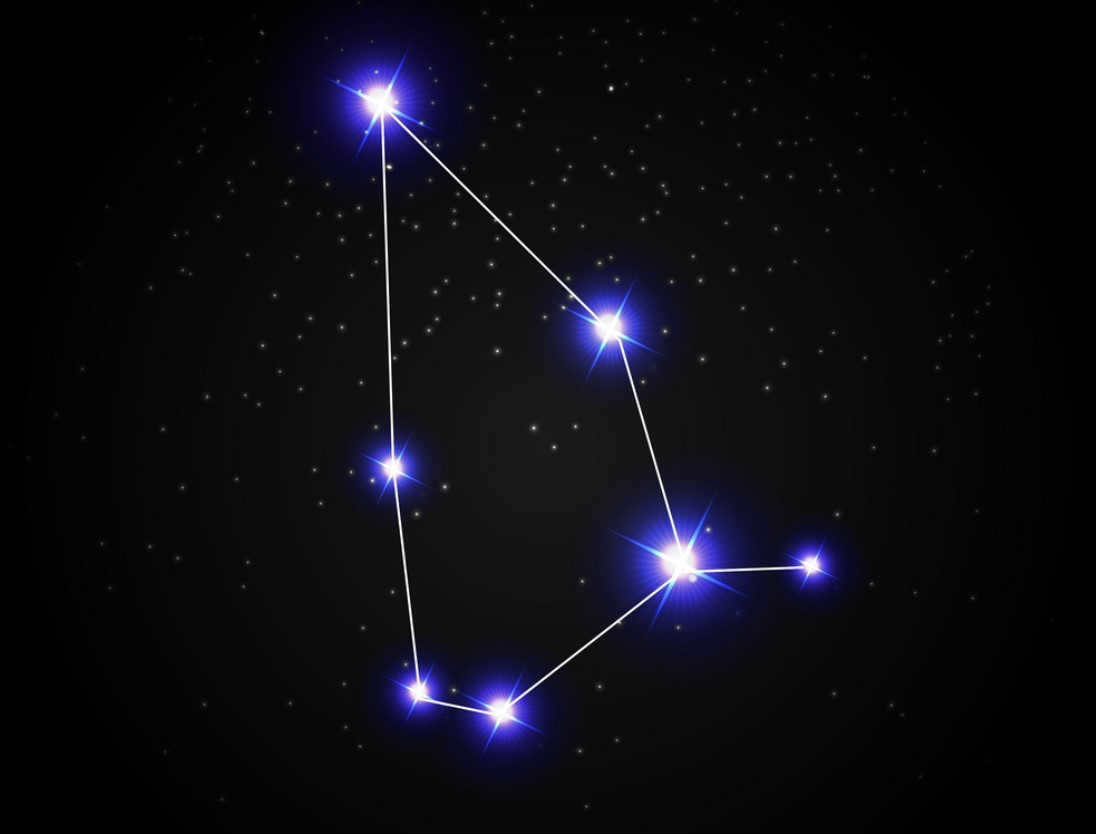
Region: Spans across 588 square degrees.
The constellation Cepheus can be found in the Northern Hemisphere. It covers a relatively small area of 588 square degrees. It is possible to observe 148 stars without the need for astronomical instruments. Nearby is the constellation Ursa Minor, which is easily visible to anyone.
Cepheus has an irregular pentagon shape and does not have any particularly bright stars. In Russia, despite its low brightness, the constellation can be observed throughout the year. Cepheus is particularly famous because the North Pole of the Earth will shift in its direction, although this event will not occur for another 1000 years.
The origin of the constellation is explained in Greek mythology. It is said to have been based on Cepheus, the ancient king of Ethiopia. However, astronomers believe that the timeline does not align, as it was formed during later stages of the universe’s formation.
3. Centaurus (Centaurus)

Centaurus: Covers an area of 1060 square degrees.
Centaurus is another constellation that holds a record for its large area, spanning 1060 square degrees. Unfortunately, individuals in the Northern Hemisphere are unable to witness its captivating beauty.
Located in the Southern Hemisphere, Centaurus lies on an imaginary line connecting the Big Dipper and Virgo. Individuals residing in Russia can catch a glimpse of this constellation, with visibility improving the further south one goes. However, it is not possible to observe the entire constellation within our country. Numerous bright stars come together to form the peculiar shape of Centaurus.
If the legends are to be believed, the centaur is known by two different names. In one myth, the centaur is called Chiron and is said to be the offspring of the renowned god Cronus and the captivating nymph Phyllis. However, another legend claims that the centaur is named Pholus and was actually sent soaring into the heavens by the mighty hero Heracles. Before his ascent, Heracles shot Pholus with a poisonous arrow.
4. Virgo
Virgo is the fourth astrological sign in the zodiac. It is symbolized by the virgin maiden. People born under the sign of Virgo are known for their analytical and practical nature. They are often perfectionists and pay great attention to detail. Virgos are also known to be hardworking, organized, and reliable. They have a strong sense of responsibility and can be relied upon to get the job done. Virgos are often seen as reserved and shy, but they are also known for their kindness and helpfulness. They have a strong desire to be of service to others and are often found in professions such as healthcare, teaching, and counseling. Virgos are also known for their ability to remain calm and collected in stressful situations. They are natural problem solvers and can often come up with creative solutions to difficult problems. In relationships, Virgos are loyal and devoted partners. They value honesty and communication and are always willing to put in the effort to make a relationship work. Overall, Virgos are practical, hardworking, and reliable individuals who are always ready to lend a helping hand.

Virgo’s Area: 1,294 square degrees.
The constellation of Virgo, which is the second largest, covers an area of 1,294 square degrees. It can be found in the night sky between Libra and Virgo, along the celestial equator. Virgo is notable for being located at the same position as the autumnal equinox point.
Historical star charts depict the constellation as a graceful maiden holding a sheaf of wheat. This beautiful image may not be easily visible to the naked eye. However, one can easily locate Virgo by using a reference point – the brightest star, Spica. Without the aid of a telescope or other instruments, a total of 171 stars can be observed.
Greek mythology also recounts the tale of its origins. Dika, the goddess of justice, grew disillusioned with humanity and made the decision to abandon them and take up residence in the heavens. She carefully selected her location, positioning herself near the Libra constellation.
5. Hydra
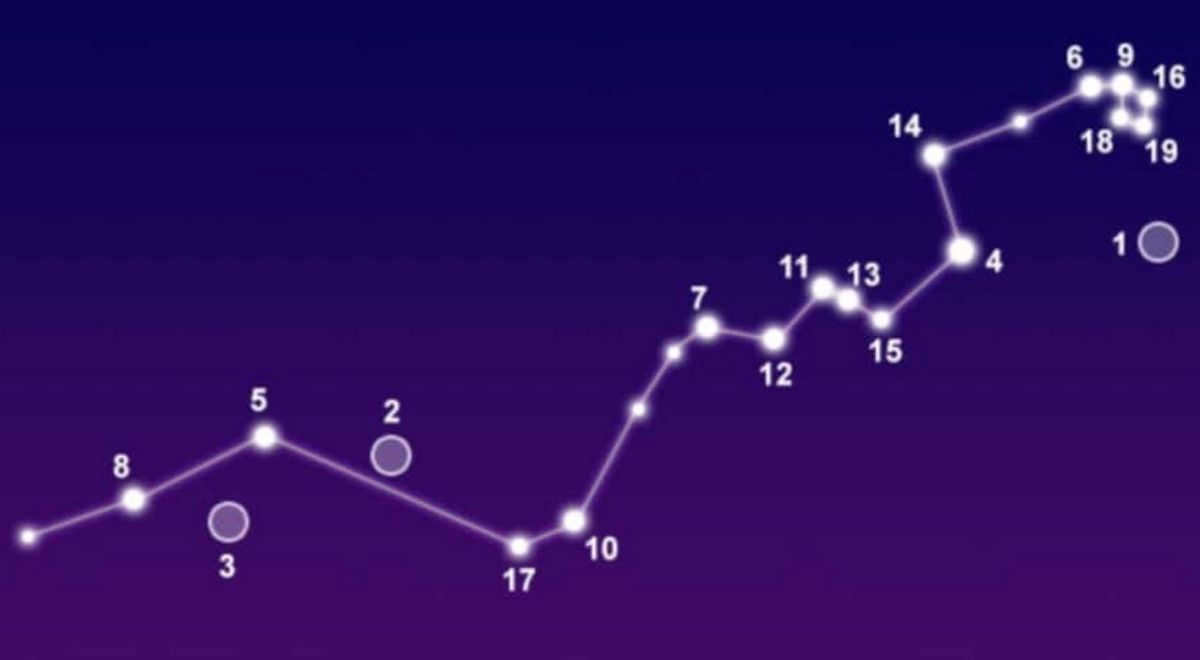
Region: Covering an area of 1303 square degrees.
The constellation Hydra holds the distinction of being the largest, spanning an impressive 1303 square degrees. It can be found in the Southern Hemisphere.
For those residing in Russia, the optimal time to observe Hydra is during the spring or late winter. The constellation is best viewed from southern latitudes.
Despite their lack of significant brightness, a total of 229 stars can be seen with the naked eye. Hydra boasts several intriguing stars, including Xi Hydra, Gamma, Alpha Hydra, and various scattered clusters.
The original form of Hydra was a water serpent. Apollo dispatched his raven to retrieve water, however, the raven was gone for an extended period of time. In order to make amends and appease his master, the raven presented the god with a snake. Apollo angrily flung the “gift”, along with the raven and the bowl of water, into the heavens. As a result, the constellations Hydra and Raven became visible in the night sky.
Another interpretation tells of Hydra as a monstrous creature with seven heads, which was ultimately outsmarted and defeated by Perseus.
6. Cassiopeia (Cassiopeia).
Cassiopeia, also known as the Queen, is a constellation in the northern sky. It is named after the queen Cassiopeia in Greek mythology. Cassiopeia is easily recognizable due to its distinctive W shape, which is formed by five bright stars. The constellation is visible throughout the year in the northern hemisphere and is located opposite the Big Dipper. Cassiopeia is home to many interesting celestial objects, including several star clusters and nebulae. It is a popular target for stargazers and astronomers, who enjoy exploring its beauty and learning about its fascinating history.
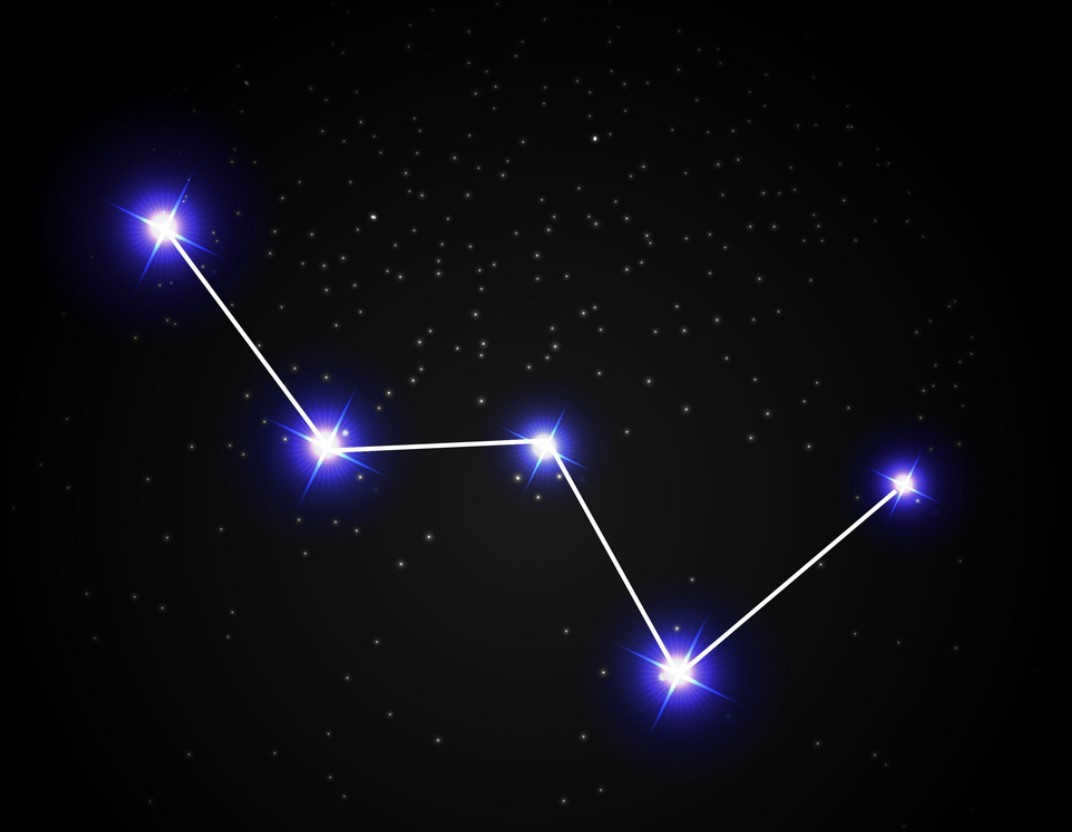
Places: Covering an area of 598 square degrees.
The renowned constellation Cassiopeia can be found in the Northern Hemisphere, allowing for year-round observation. However, the ideal time to view it is during the autumn season.
Its shape is reminiscent of the letter W. It covers an approximate area of 598 square degrees. The primary structure of the constellation consists of 5 exceptionally bright stars, with an additional 90 stars being observable.
This constellation is named after the wife of the ancient king Cepheus. Cassiopeia, a member of the royal family, is also the mother of Andromeda. Due to her arrogance, she was punished by being tied to a throne. To this day, she revolves around the pole and, once a day, takes an inverted position.
7. Pegasus
Pegasus is a mythical winged horse that is often depicted in Greek mythology. It is said to have been born from the blood of the Gorgon Medusa after she was slain by the hero Perseus. Pegasus is known for its ability to fly and is often associated with poetry and inspiration. In some stories, Pegasus is ridden by the hero Bellerophon, who uses the horse’s flying abilities to defeat various monsters. Pegasus has become a symbol of freedom and the power of the imagination.
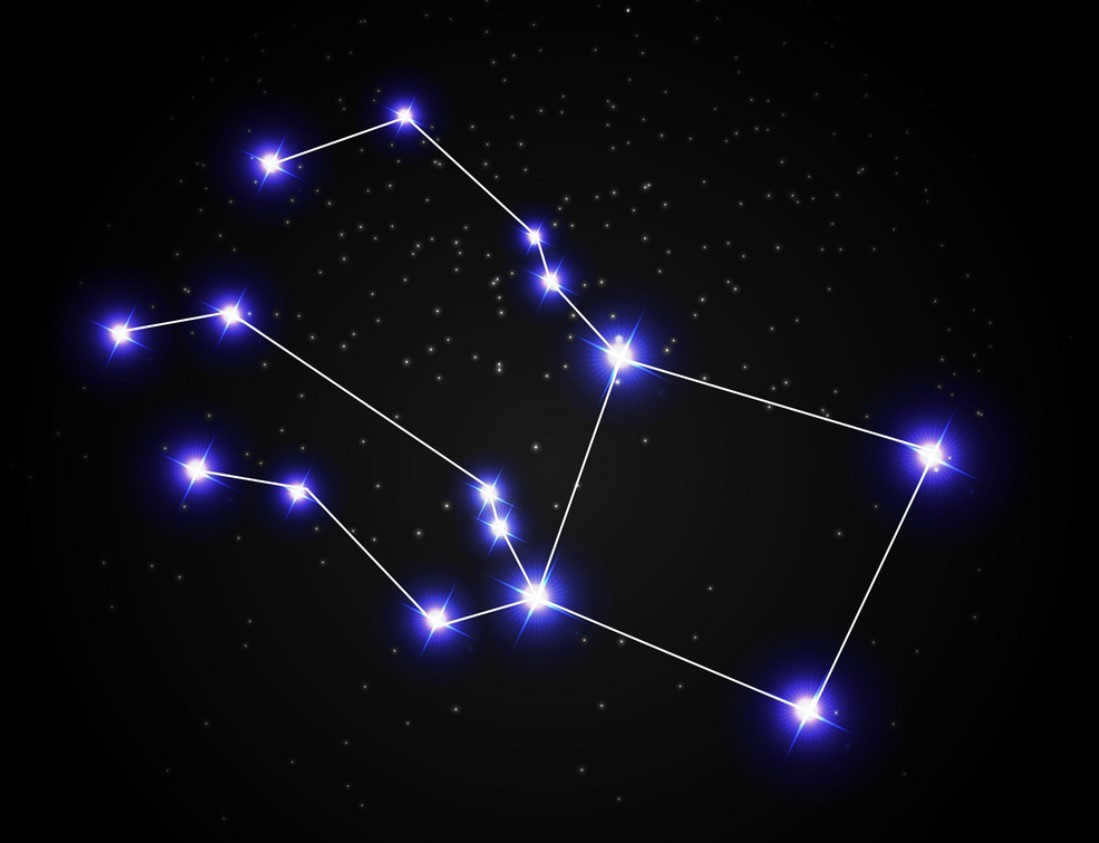
Constellation Area: Covers an expanse of 1121 square degrees.
Pegasus, also known as the winged horse, is one of the larger constellations located in the Northern Hemisphere. It spans an area of 1121 square degrees in outer space. Interestingly, one can easily observe 166 stars within this constellation without the need for any astronomical instruments. The optimal viewing period for Pegasus is during early fall and late summer.
In terms of its shape, Pegasus resembles a massive square with stars scattered around it, almost resembling tentacles. It requires a vivid imagination to visualize the mythical winged horse instead of the geometric shape it is often associated with.
Pegasus, the winged horse, has a prominent role in Greek mythology. According to the legends, it was born from the blood of the Gorgon, whose head was severed by Perseus.
8. Hercules
can be paraphrased as
8. The legendary hero Hercules
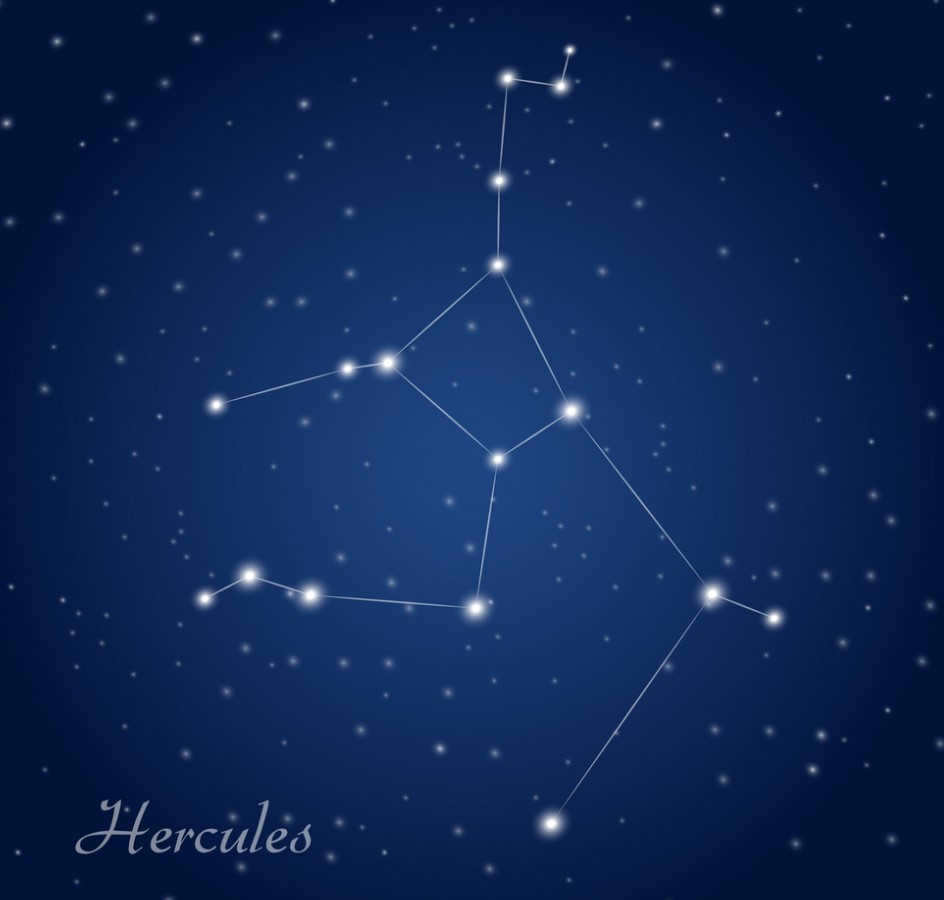
Locations: Covering an area of 1225 square degrees.
Situated in the Northern Hemisphere, Hercules is a constellation associated with the legendary hero of myths. It occupies an approximate area of 1225 square degrees and is widely recognized as one of the most prominent constellations in the night sky.
The stars that form a trapezoid shape represent the torso of the mythical titan and are the most easily visible part of the constellation. In Russia, Hercules can be observed in its entirety, except during the time of its lowest point in the sky. During the month of June, it is particularly prominent.
Originally named Kneeling, this cluster of stars was identified by the ancient poet Aratus as a depiction of a suffering husband. However, the true cause of his suffering was not specified by the poet.
The ancient astronomers in the 5th century BC gave the name Hercules to the constellation that is now known as Hercules.
9. Ursa Major (The Great Bear)
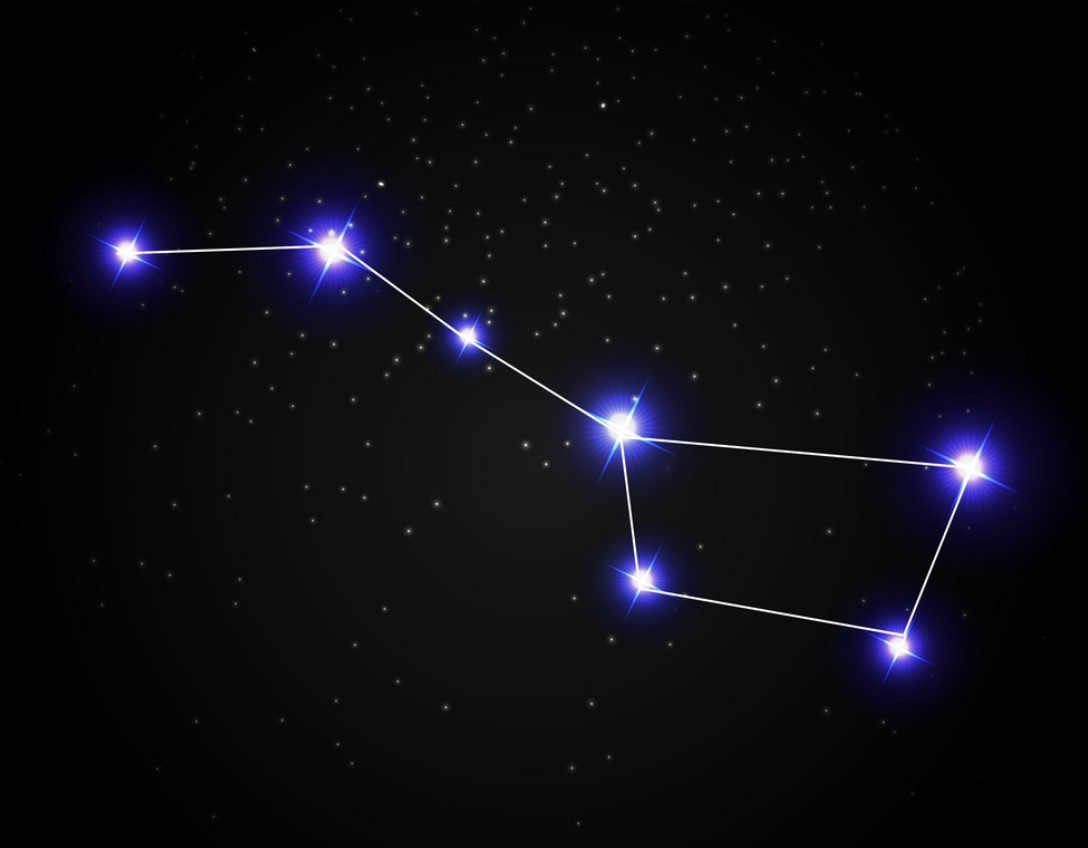
Locations: Covers an area of 1280 square degrees.
The constellation known as the Big Dipper can be found in the Northern Hemisphere. It is easily recognizable by its distinct shape, which resembles a dipper with a handle, formed by a group of bright stars. It is the third largest constellation, occupying an area of 1,280 square degrees. When observed with the naked eye, it is possible to see a total of 125 stars within this constellation.
The group of stars that form the Big Dipper, also known as an asterism, has been given various nicknames by different cultures. Additionally, there are other asterisms within the Big Dipper constellation.
Ancient Greek myths also mention the appearance of this constellation in the night sky. According to one myth, Zeus transformed the goddess Callisto into a celestial bear in order to protect her from the wrath of Hera, his wife.
10. Ursa Minor: The Small Bear.
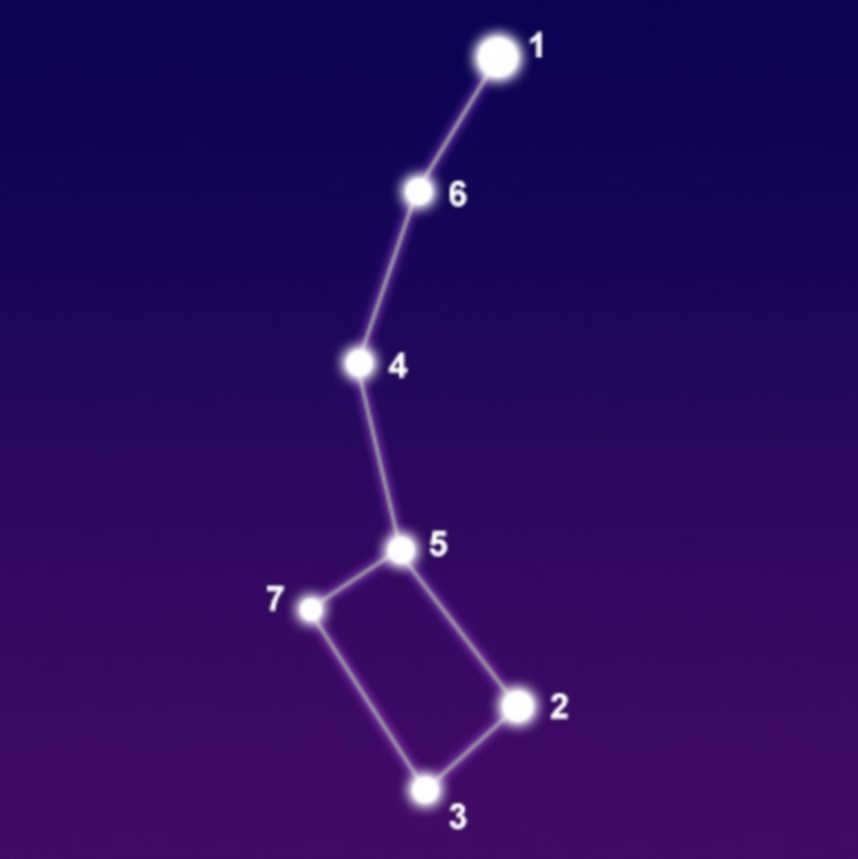
Areas: Covers an area of 256 square degrees.
The Minor Bear is a constellation located near the North Pole in the Northern Hemisphere. It should not be challenging to locate this constellation as it is situated next to the Big Dipper. In other words, they are adjacent to each other.
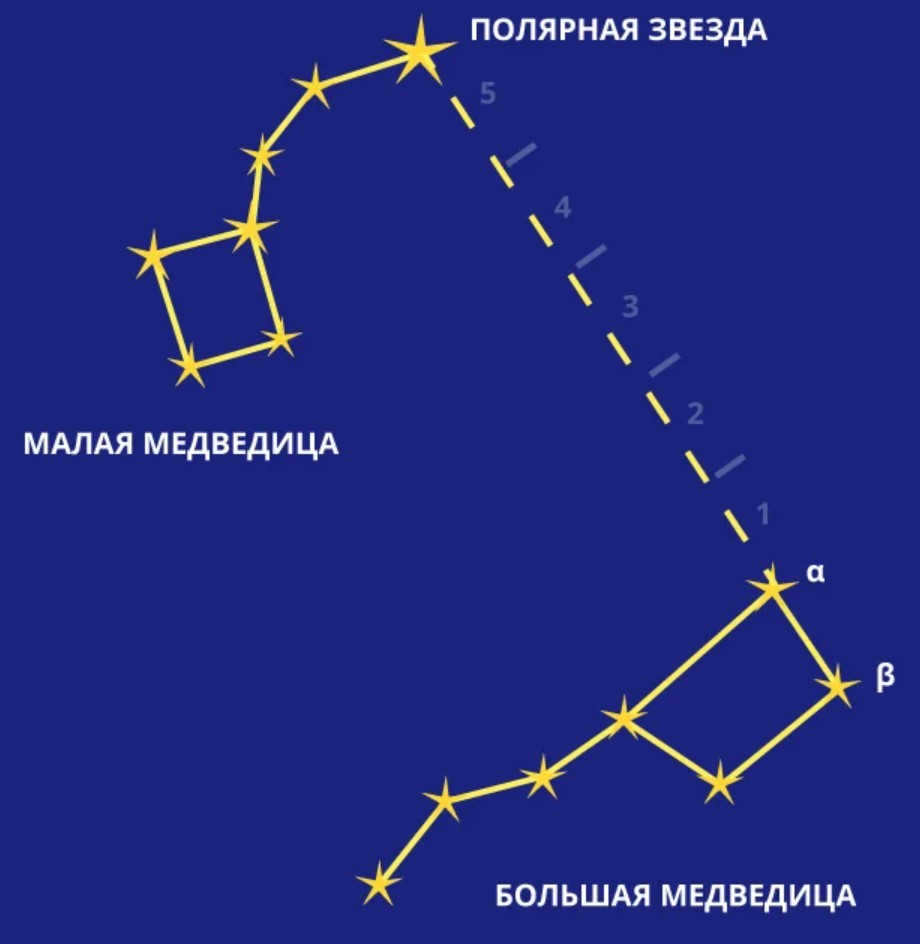
It can be observed throughout the year without any restrictions. Currently, the star of the Little Bear aligns with the North Pole of the world. There are two notable asterisms within this constellation: the Guardians of the Pole and the Little Ladle.
According to myths, the Little Dipper represents a dog that once belonged to the famous Callisto. Both the mistress and her faithful dog were transformed into stars. Zeus then placed them in the sky, granting them eternal life.
This is a collection of the most well-known constellations, each with its own unique history that has been passed down through the centuries.
Constellations are groups of stars that scientists have grouped together because they form recognizable shapes in the sky.
Ancient civilizations categorized stars into constellations in various manners. Additionally, different stars become visible in different regions of the world.
The International Astronomical Union, which includes Russia, examined and employed constellations that were initially identified by astronomers from the Mediterranean. In 1922, the Union officially acknowledged 88 constellations as legitimate constellations. This list encompasses 49 ancient constellations (originally discovered by Romans and Greeks) as well as contemporary constellations.
List of star patterns
Arrangement of star patterns
Of course, not all stars create star patterns, as there are over a hundred billion of them. Thus, star patterns encompass only the most luminous ones.
Researchers divided the celestial sphere into regions of various forms and dimensions. All the stars that fall within a segment of a star pattern are considered part of that star pattern.
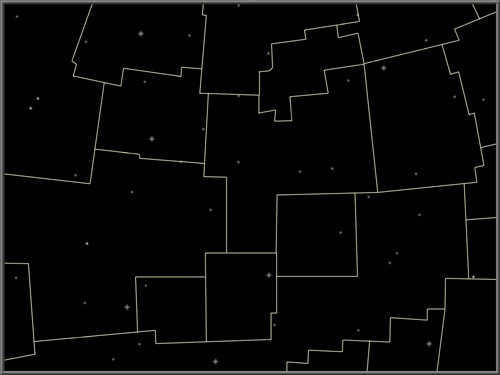
All of the stars visible in the night sky are part of the Milky Way galaxy. However, the constellations we see vary depending on the time of year and the Earth’s position in its orbit around the Sun.
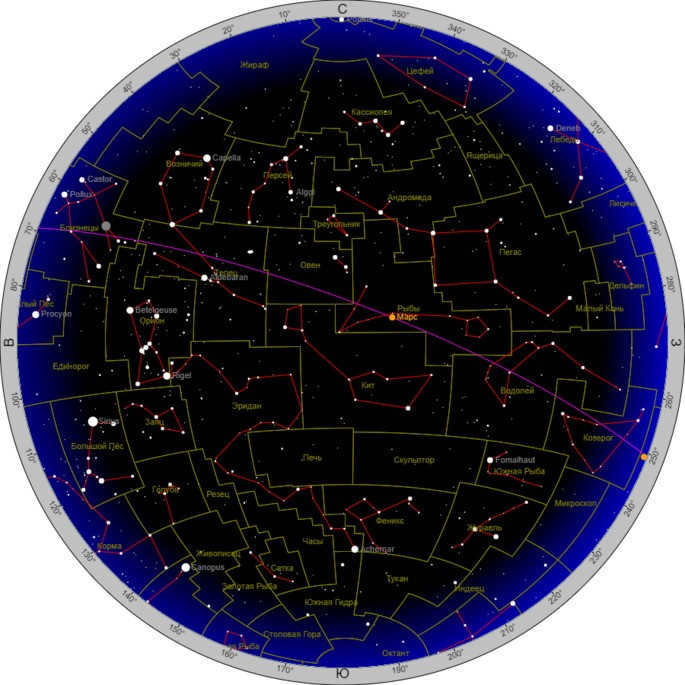
Constellations in the Southern and Northern Hemispheres
When we are located in a particular hemisphere, we can observe the sky dome above us. This dome represents approximately 180 degrees of the entire celestial sphere, which corresponds to the shape of our planet Earth.
Therefore, individuals in one hemisphere can only see the constellations that are directly above them. To view the constellations on the other side of the celestial sphere, one must relocate to the opposite hemisphere.
Imagine standing on an orange and looking upwards; you can only see the space above the orange (in the Southern Hemisphere).
As a result, astronomers categorize constellations based on their visibility in either the Southern or Northern Hemisphere.
The constellations in the southern hemisphere include:
- The Great Dog,
- The Wolf,
- The Raven,
- The Dove,
- The Sacristan,
- The Painter,
- The Crane,
- The Hare,
- The Goldfish,
- The Indian,
- Kiel,
- The Capricorn,
- The Compass,
- The Feeds,
- The Flying Fish,
- The Microscope,
- The Fly,
- The Pump,
- The Naugolnik,
- The Octant,
- The Peacock,
- The Sails,
- The Stove,
- The Bird of Paradise,
- The Chisel,
- The Grid,
- The Scorpion,
- The Table Mountain,
- The Sagittarius,
- The Telescope,
- The Toucan,
- The Phoenix,
- The Chameleon,
- The Centaurus,
- The Circulus,
- The Clock,
- The Cup,
- The Shield,
- The Southern Hydra,
- The constellations in the southern hemisphere include:
- Southern Crown,
- Southern Fish,
- Southern Cross,
- Southern Triangle.
The constellations in the northern hemisphere include:
- Andromeda,
- Gemini,
- the Big Dipper,
- the Wolf,
- Veronica’s hair,
- Hercules,
- Hound Dogs,
- Dolphin,
- Dragon,
- Giraffe,
- Cassiopeia,
- Swan,
- Lyra,
- Foxy,
- Little Bear,
- the Lesser Horse,
- Little Leo,
- Aries,
- Pegasus,
- Perseus,
- Cancer,
- Lynx,
- Northern Crown,
- Sextant,
- Arrow,
- Triangle,
- Cepheus,
- Lizard.
Zodiacal constellations
The zodiac is a make-believe line encircling the Earth, which contains a collection of constellations.
The Earth orbits around the Sun. However, when we are on Earth, we can observe an imaginary line along which the Sun moves in the sky throughout the year. This line is known as the ecliptic.
The zodiacal constellations are those constellations on the zodiac through which the Sun’s ecliptic passes.
They are also referred to as the zodiac signs. In total, there are 12:
- Aries,
- Taurus,
- Gemini,
- Cancer,
- Leo,
- Virgo,
- Libra,
- Scorpio,
- Sagittarius,
- Capricorn,
- Aquarius,
- Pisces.
Astrology places significant importance on these signs. It is a doctrine that originated in ancient times and remains prevalent today, exploring the impact of the cosmos, stars, and celestial bodies on various aspects of human life, including personality traits, future prospects, and cognitive processes.
The Origins of Constellations
The first compilation of constellations was created by astronomer and mathematician Claudius Ptolemy in 140 B.C., encompassing a total of 48 constellations. These constellations hold deep historical significance, often deriving their names from gods and mythical figures such as Orion, Cepheus, Pegasus, and Andromeda. Many of these constellations continue to be recognized in modern times.
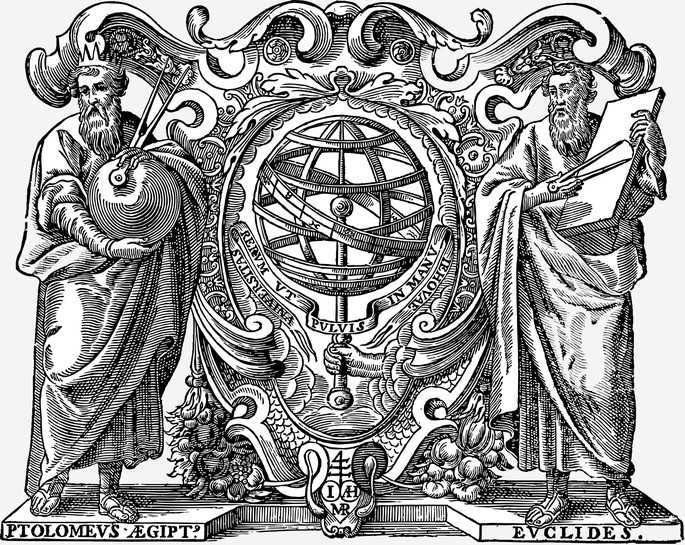
In 1603, the German astronomer Johann Bayer developed a contemporary atlas titled Uranometria. This atlas stands out because it only deviates 1 angular minute from the precise positions of the stars, which were observed using state-of-the-art telescopes.
Why constellations are necessary
In the past, constellations served the purpose of aiding navigation and providing orientation on land.
Understanding constellations enabled people in ancient times to determine the seasons without the use of calendars. The stars were utilized to determine optimal times for planting and harvesting crops.
Due to the Earth’s rotation on its axis and around the Sun, constellations appear in different positions in the sky depending on the time of year. For instance, the Orion constellation becomes most prominent as winter approaches.
The night sky constantly captivates the gaze, but it is especially captivating when adorned with stars.
A multitude of stars are organized into specific constellations, each with its own distinct name. Each constellation derives its name from a captivating legend.
To identify star clusters on your own, you can utilize a specialized astronomical chart, which will aid you in recognizing the astrological signs.
The index of constellations in alphabetical order will inform you of the multitude of popular groups of celestial bodies that exist in the cosmos.
Legends surrounding the etymology of constellation names
Any grand event or adventure, as well as the etymology of their names, is intertwined with myths and folklore.
The names of celestial bodies are also intimately connected to myths, from which you can glean their history. The names of all constellations were derived from their respective shapes.
The manner in which a person perceives the stars does not necessarily reflect their actual arrangement in the sky: each star is situated at a considerable distance from one another.
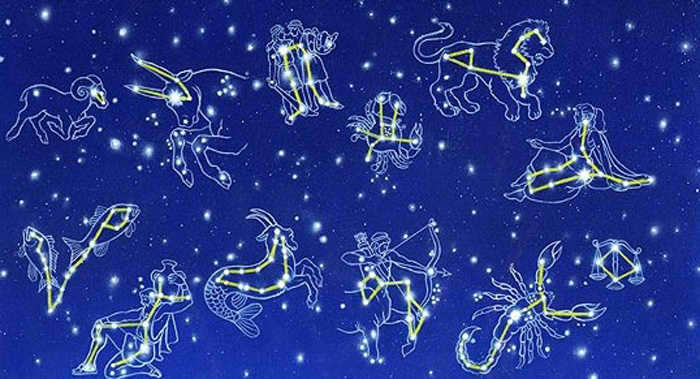
To gain a better understanding of their names, let’s explore a few origin myths:
- Cassiopeia. According to the story, the proud wife of Cepheus, the ruler of Ethiopia, bragged to the sea nymphs about her own beauty and that of her daughter.
In response, the sea nymphs asked Poseidon to punish Cassiopeia. Poseidon unleashed a massive sea monster that attacked Ethiopia. In order to save their kingdom, Cepheus and Cassiopeia had to sacrifice their daughter.
Legend has it that the Egyptian queen Veronica, while sending her husband off to war, made a vow to the gods to give up her beautiful hair.
However, Hera, the wife of Zeus, discovered Veronica’s promise and transformed her into a clumsy bear. Years later, Arkad, the son of Veronica and her lover, came across this bear-woman in the forest and attempted to kill her.
Legends of this kind are so fascinating with their incredible nature: if you manage to locate constellations in the sky through photographs, you can actually discover evidence supporting some mythical tales.
Alphabetical List of Constellations and Photographs
Most names have been given in honor of mythological heroes from Ancient Greece, animals, or significant objects from modern times.
Quite often, astronomers have named clusters of celestial bodies based on the shapes they resemble.
But here’s the catch! The starry sky map is adorned with numerous stars, and with the aid of a photograph, you can easily identify the desired constellation if you step outside on a clear night.
Thanks to these names, contemporary scientists are able to gain further insights into the lifestyles and mindset of those who lived before us.

Here is a collection of names in alphabetical order along with their corresponding images:
| Name | Total number of stars | Number of stars visible to humans |
| Andromeda | 54 | 3 |
| Ursa Major | 71 | 6 |
| Canis Major | 56 | 5 |
| Pica | 53 | 2 |
| Corvus | 11 | 0 |
| Hercules | 85 | 0 |
| Hydra | 71 | 1 |
| Delphinus | 11 | 0 |
| Monoceros | 36 | 0 |
| Pictor | 15 | 0 |
| Serpens | 55 | 2 |
| Indus | 13 | 0 |
| Cygnus | 79 | 3 |
| Equuleus | 5 | 0 |
| Crater | 9 | 0 |
| Aquila | 47 | 1 |
| Pavo | 28 | 1 |
| Lynx | 31 | 0 |
| Reticle | 11 | 0 |
| Telescopium | 17 | 0 |
| Phoenix | 27 | 1 |
| Chamaeleon | 13 | 0 |
| Circulus | 10 | 0 |
| Crater | 11 | 0 |
| Scutum | 9 | 0 |
| Triangulum Australe | 12 | 1 |
| Lacerta | 23 | 0 |
Discovering the Location of Your Zodiac Constellation in the Celestial Map
People of all ages often wonder how they can locate their respective zodiac constellation in the night sky. Fortunately, there is a helpful tool available for this purpose: a celestial map.
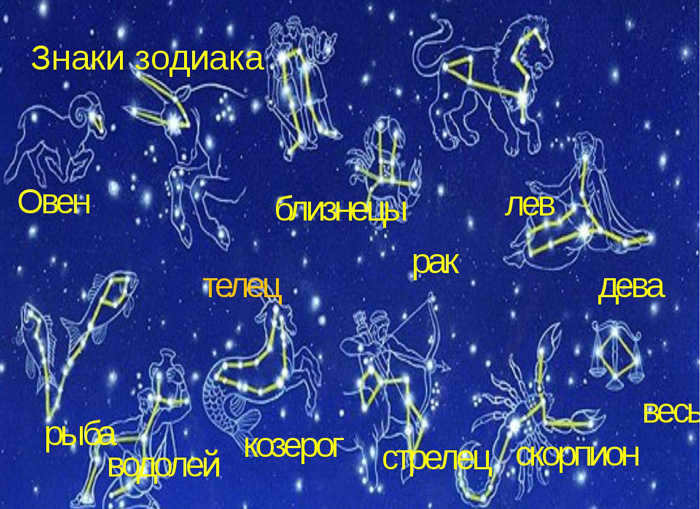
The southern and northern hemispheres of space are divided into distinct clusters of stars:
- The Aries constellation bears a resemblance to a tick, symbolizing the horns of the creature.
- Taurus is composed of 14 distinct stars that appear as two separate constellations.
- Gemini bears a striking resemblance to two human figures in the sky.
- The constellation of Cancer resembles a triangle with a branching stripe.
- Leo is renowned as the brightest constellation and truly resembles the silhouette of an animal.
- Virgo is recognized as the largest sign and takes the form of a disproportionate rectangle with four stripes.
- Libra appears as a triangle with rays emanating from it.
- Scorpio consists of 17 stars and its shape in the sky resembles a fork.
- Sagittarius is represented by 14 bright stars that form a complex composition of celestial bodies.
- In winter, Capricorn can be identified by its distinct heart-shaped cluster.
- Aquarius is a collection of rays.
- When looking at the Pisces constellation on Earth, it appears as an incomplete triangle during the day of the vernal equinox.
To explore the most popular constellations, go outside on a clear night and locate the Big Dipper – from there, you can try to identify other star clusters.
The symbols used for the Zodiac signs in horoscopes today do not accurately represent their true shape in the sky.
Tales of the constellation of Orion
The world around us is teeming with an abundance of enigmas, myths, and fables. Numerous stories have been spun to explain the genesis of star clusters.
Among the most captivating narratives are those revolving around the constellation of Orion.
This assemblage of stars showcases one of the most resplendent constellations in the southern celestial hemisphere.
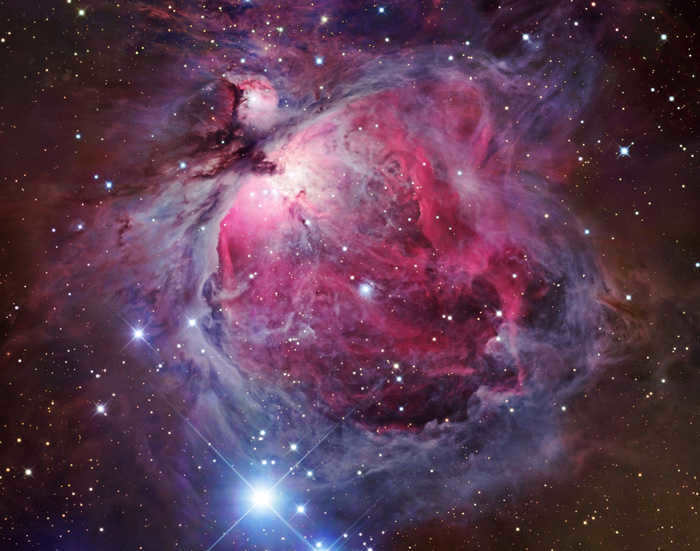
There are numerous stories surrounding this group of celestial objects:
-
In mythology, Orion was the son of Poseidon: According to legend, he possessed the ability to defeat all creatures, which led Hera to send a Scorpion to attack him.
Orion was ultimately killed by the Scorpion’s bite during an unequal struggle for the heart of Princess Merope.
One of the brothers, who remained unmarried, was more handsome than the other, leading him to believe that his relative was envious.
These tales can be shared with young children to introduce them to the diverse cultures of the world. Each constellation has its own unique legends.
Appreciating the beauty of the night sky does not require an in-depth knowledge of mythology.

